Strategic Planning for Tourism and Leisure in Broadstairs Coastal Area
VerifiedAdded on 2021/04/30
|23
|5814
|169
Report
AI Summary
This report delves into strategic planning for tourism and leisure, specifically focusing on the Broadstairs coastal area in East Kent, UK. It begins by examining the benefits of producing strategic tourism plans for coastal regions, illustrating these advantages with the successful example of the Maldives. The report emphasizes the economic, environmental, and social benefits of such planning, including improved local economies, infrastructure development, and the preservation of cultural heritage. The second part of the report evaluates the importance of collaborative planning in tourism, justifying its usefulness for Broadstairs. It discusses the pros and cons of this approach, highlighting how collaborative efforts among stakeholders can enhance decision-making, foster innovation, and address challenges within the tourism industry. The report also references case studies like Sitka Island in Alaska and Cusco, Peru to support the effectiveness of the collaborative approach. The report concludes by summarizing key findings and recommendations for the strategic development of tourism in Broadstairs.
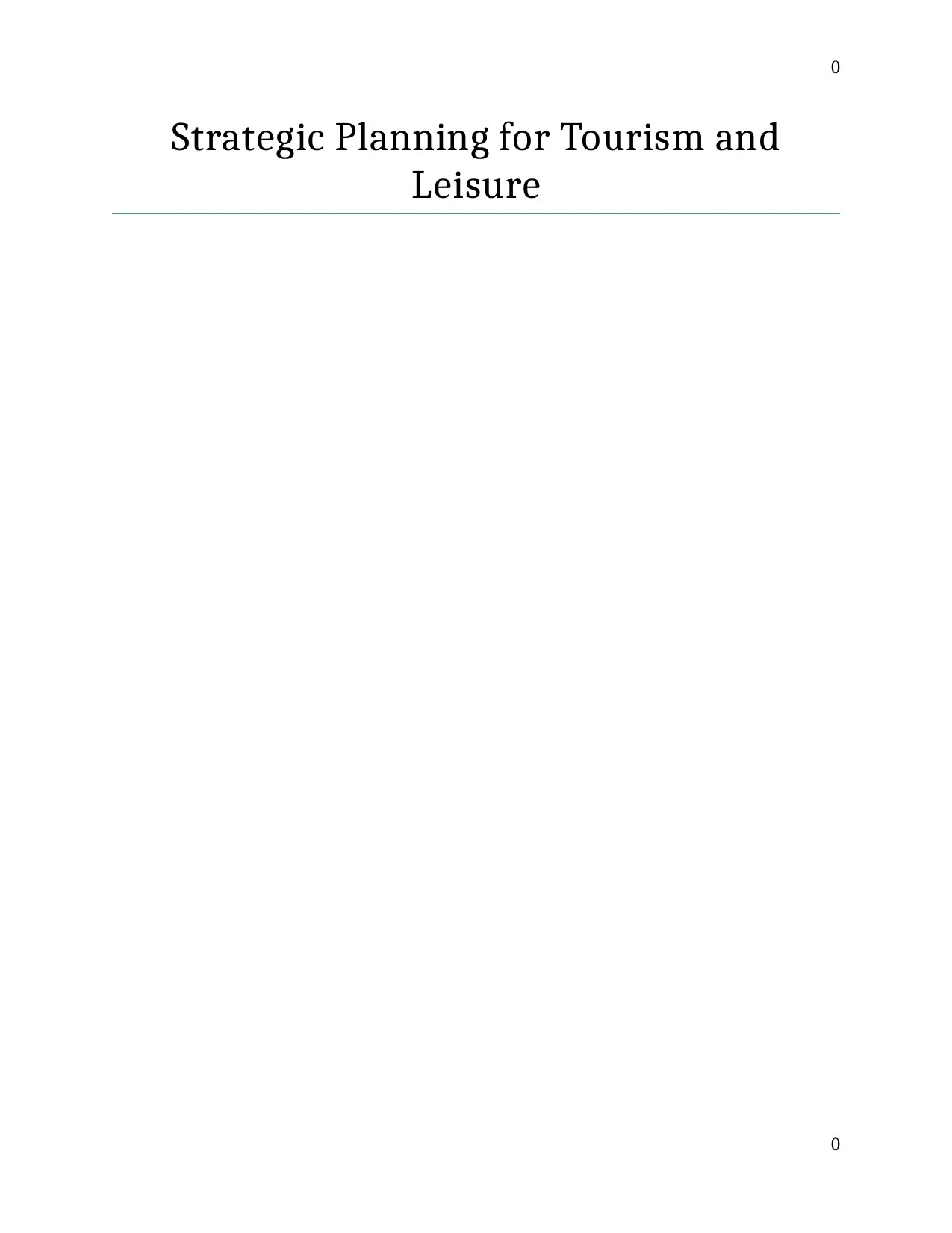
0
Strategic Planning for Tourism and
Leisure
0
Strategic Planning for Tourism and
Leisure
0
Secure Best Marks with AI Grader
Need help grading? Try our AI Grader for instant feedback on your assignments.
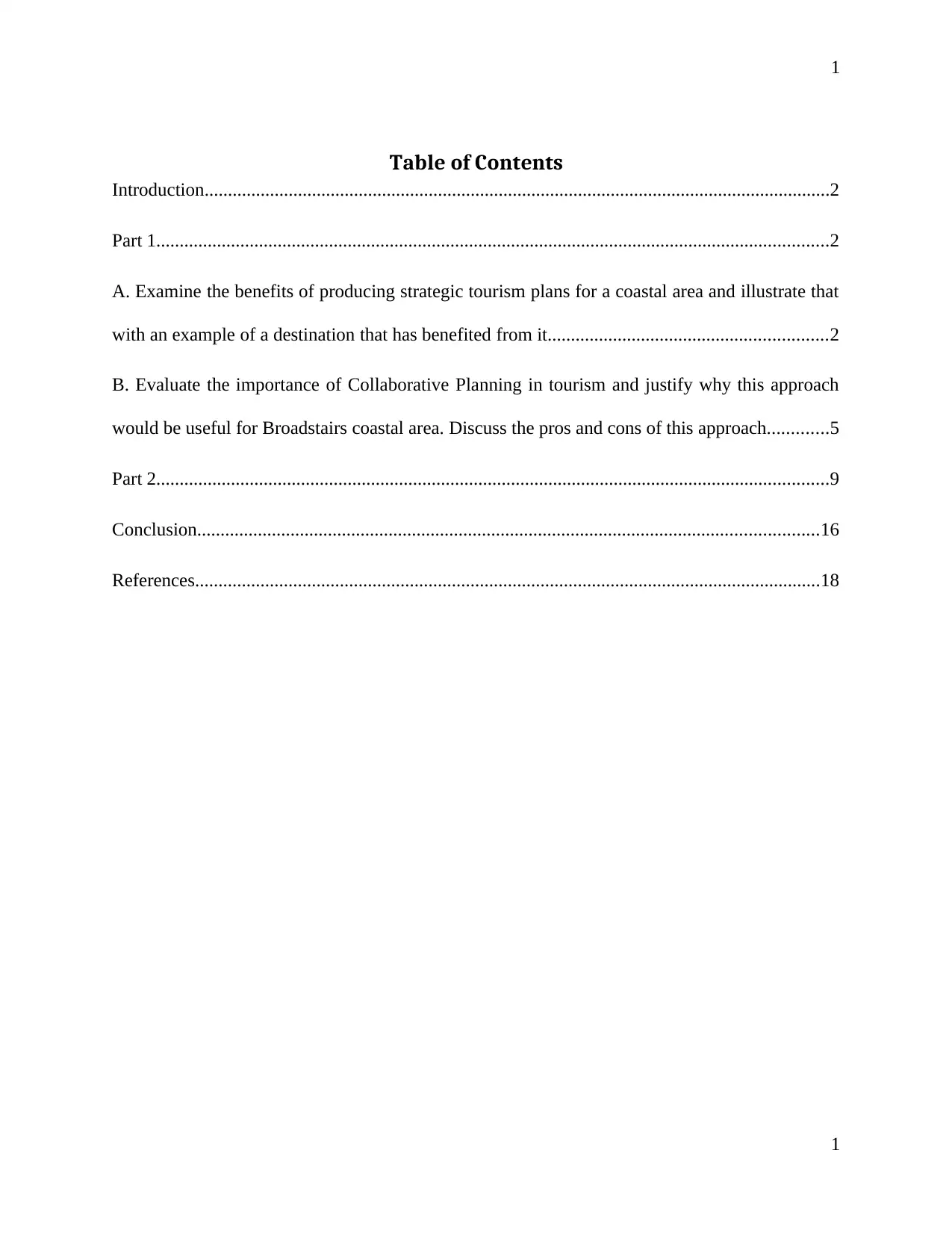
1
Table of Contents
Introduction......................................................................................................................................2
Part 1................................................................................................................................................2
A. Examine the benefits of producing strategic tourism plans for a coastal area and illustrate that
with an example of a destination that has benefited from it............................................................2
B. Evaluate the importance of Collaborative Planning in tourism and justify why this approach
would be useful for Broadstairs coastal area. Discuss the pros and cons of this approach.............5
Part 2................................................................................................................................................9
Conclusion.....................................................................................................................................16
References......................................................................................................................................18
1
Table of Contents
Introduction......................................................................................................................................2
Part 1................................................................................................................................................2
A. Examine the benefits of producing strategic tourism plans for a coastal area and illustrate that
with an example of a destination that has benefited from it............................................................2
B. Evaluate the importance of Collaborative Planning in tourism and justify why this approach
would be useful for Broadstairs coastal area. Discuss the pros and cons of this approach.............5
Part 2................................................................................................................................................9
Conclusion.....................................................................................................................................16
References......................................................................................................................................18
1
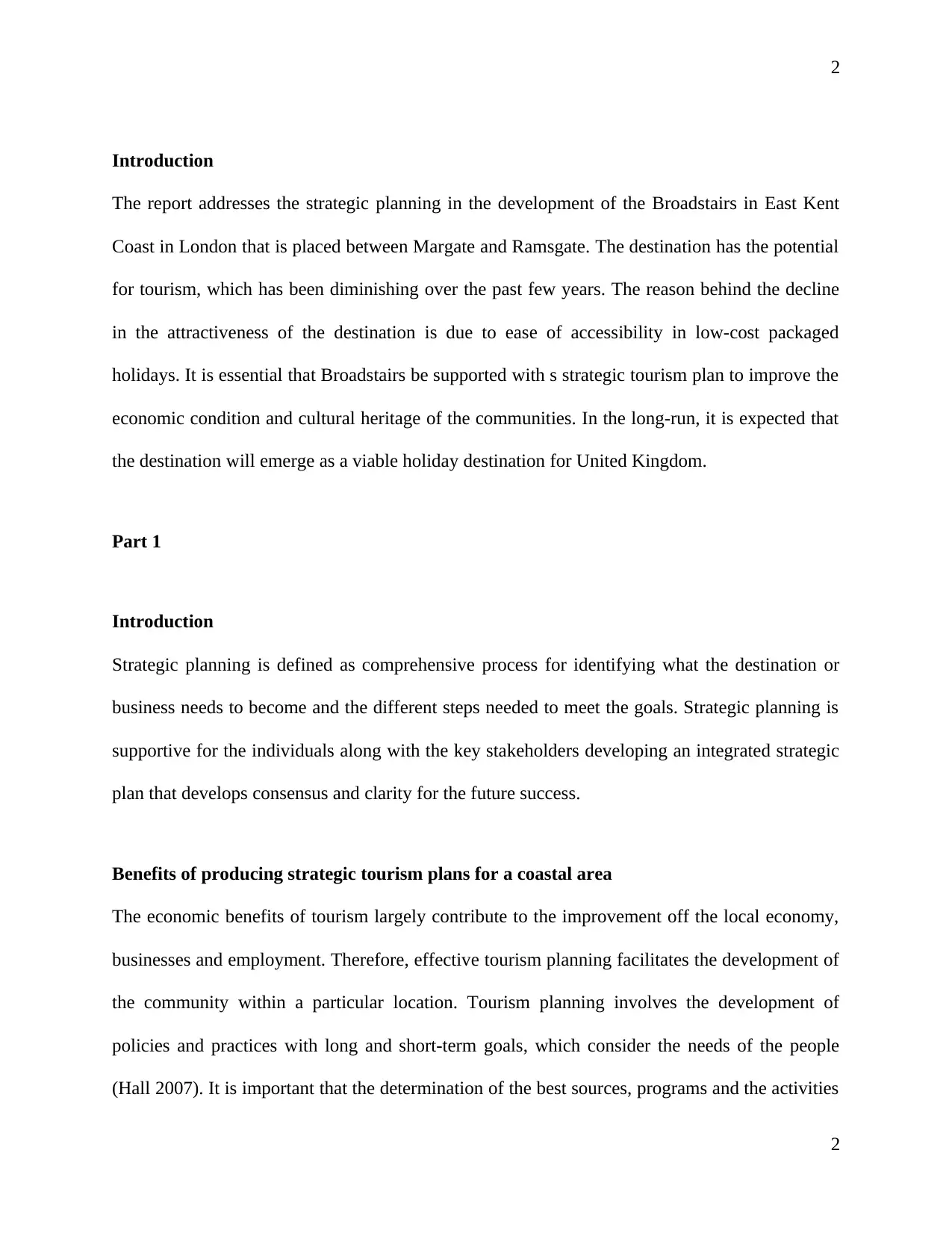
2
Introduction
The report addresses the strategic planning in the development of the Broadstairs in East Kent
Coast in London that is placed between Margate and Ramsgate. The destination has the potential
for tourism, which has been diminishing over the past few years. The reason behind the decline
in the attractiveness of the destination is due to ease of accessibility in low-cost packaged
holidays. It is essential that Broadstairs be supported with s strategic tourism plan to improve the
economic condition and cultural heritage of the communities. In the long-run, it is expected that
the destination will emerge as a viable holiday destination for United Kingdom.
Part 1
Introduction
Strategic planning is defined as comprehensive process for identifying what the destination or
business needs to become and the different steps needed to meet the goals. Strategic planning is
supportive for the individuals along with the key stakeholders developing an integrated strategic
plan that develops consensus and clarity for the future success.
Benefits of producing strategic tourism plans for a coastal area
The economic benefits of tourism largely contribute to the improvement off the local economy,
businesses and employment. Therefore, effective tourism planning facilitates the development of
the community within a particular location. Tourism planning involves the development of
policies and practices with long and short-term goals, which consider the needs of the people
(Hall 2007). It is important that the determination of the best sources, programs and the activities
2
Introduction
The report addresses the strategic planning in the development of the Broadstairs in East Kent
Coast in London that is placed between Margate and Ramsgate. The destination has the potential
for tourism, which has been diminishing over the past few years. The reason behind the decline
in the attractiveness of the destination is due to ease of accessibility in low-cost packaged
holidays. It is essential that Broadstairs be supported with s strategic tourism plan to improve the
economic condition and cultural heritage of the communities. In the long-run, it is expected that
the destination will emerge as a viable holiday destination for United Kingdom.
Part 1
Introduction
Strategic planning is defined as comprehensive process for identifying what the destination or
business needs to become and the different steps needed to meet the goals. Strategic planning is
supportive for the individuals along with the key stakeholders developing an integrated strategic
plan that develops consensus and clarity for the future success.
Benefits of producing strategic tourism plans for a coastal area
The economic benefits of tourism largely contribute to the improvement off the local economy,
businesses and employment. Therefore, effective tourism planning facilitates the development of
the community within a particular location. Tourism planning involves the development of
policies and practices with long and short-term goals, which consider the needs of the people
(Hall 2007). It is important that the determination of the best sources, programs and the activities
2
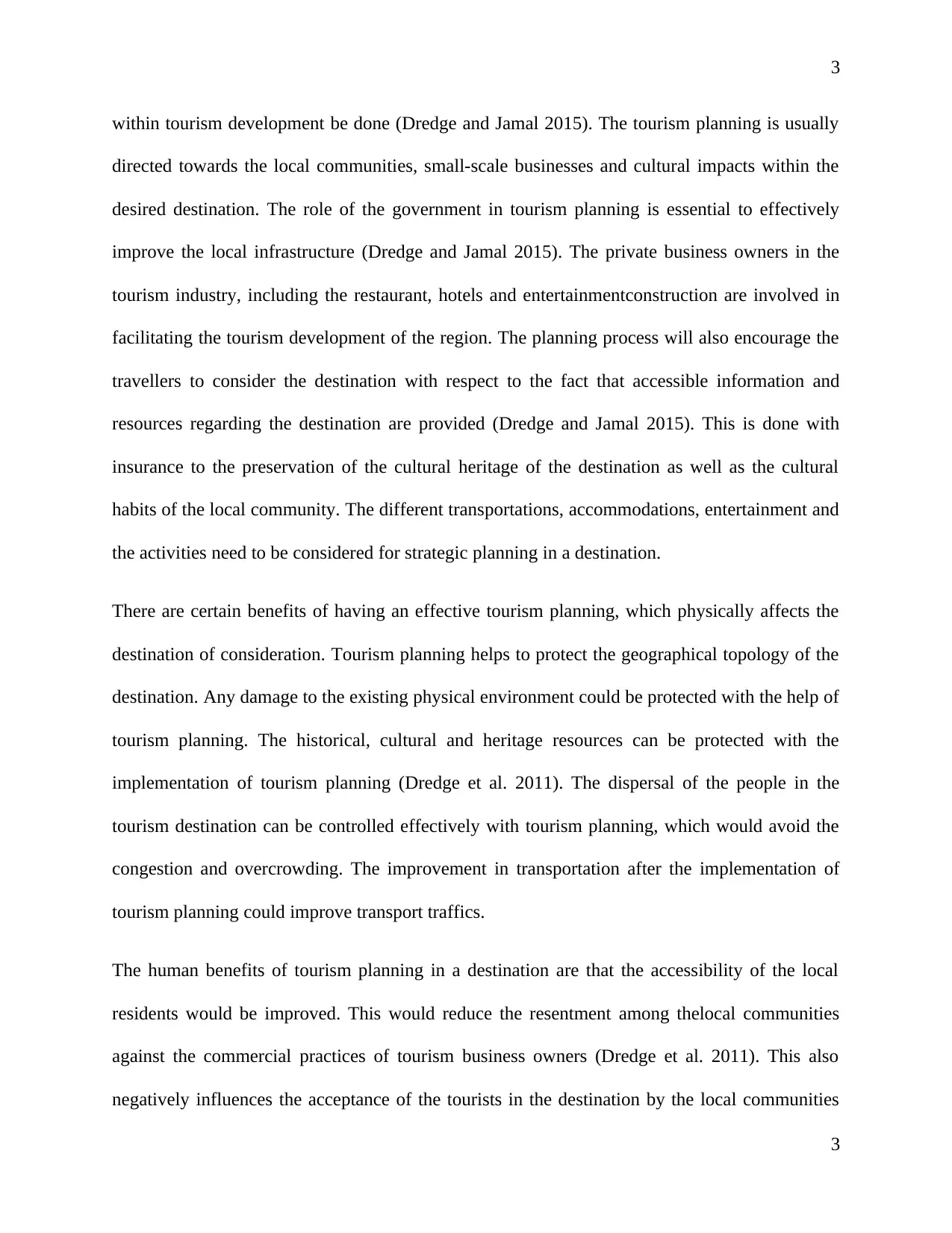
3
within tourism development be done (Dredge and Jamal 2015). The tourism planning is usually
directed towards the local communities, small-scale businesses and cultural impacts within the
desired destination. The role of the government in tourism planning is essential to effectively
improve the local infrastructure (Dredge and Jamal 2015). The private business owners in the
tourism industry, including the restaurant, hotels and entertainmentconstruction are involved in
facilitating the tourism development of the region. The planning process will also encourage the
travellers to consider the destination with respect to the fact that accessible information and
resources regarding the destination are provided (Dredge and Jamal 2015). This is done with
insurance to the preservation of the cultural heritage of the destination as well as the cultural
habits of the local community. The different transportations, accommodations, entertainment and
the activities need to be considered for strategic planning in a destination.
There are certain benefits of having an effective tourism planning, which physically affects the
destination of consideration. Tourism planning helps to protect the geographical topology of the
destination. Any damage to the existing physical environment could be protected with the help of
tourism planning. The historical, cultural and heritage resources can be protected with the
implementation of tourism planning (Dredge et al. 2011). The dispersal of the people in the
tourism destination can be controlled effectively with tourism planning, which would avoid the
congestion and overcrowding. The improvement in transportation after the implementation of
tourism planning could improve transport traffics.
The human benefits of tourism planning in a destination are that the accessibility of the local
residents would be improved. This would reduce the resentment among thelocal communities
against the commercial practices of tourism business owners (Dredge et al. 2011). This also
negatively influences the acceptance of the tourists in the destination by the local communities
3
within tourism development be done (Dredge and Jamal 2015). The tourism planning is usually
directed towards the local communities, small-scale businesses and cultural impacts within the
desired destination. The role of the government in tourism planning is essential to effectively
improve the local infrastructure (Dredge and Jamal 2015). The private business owners in the
tourism industry, including the restaurant, hotels and entertainmentconstruction are involved in
facilitating the tourism development of the region. The planning process will also encourage the
travellers to consider the destination with respect to the fact that accessible information and
resources regarding the destination are provided (Dredge and Jamal 2015). This is done with
insurance to the preservation of the cultural heritage of the destination as well as the cultural
habits of the local community. The different transportations, accommodations, entertainment and
the activities need to be considered for strategic planning in a destination.
There are certain benefits of having an effective tourism planning, which physically affects the
destination of consideration. Tourism planning helps to protect the geographical topology of the
destination. Any damage to the existing physical environment could be protected with the help of
tourism planning. The historical, cultural and heritage resources can be protected with the
implementation of tourism planning (Dredge et al. 2011). The dispersal of the people in the
tourism destination can be controlled effectively with tourism planning, which would avoid the
congestion and overcrowding. The improvement in transportation after the implementation of
tourism planning could improve transport traffics.
The human benefits of tourism planning in a destination are that the accessibility of the local
residents would be improved. This would reduce the resentment among thelocal communities
against the commercial practices of tourism business owners (Dredge et al. 2011). This also
negatively influences the acceptance of the tourists in the destination by the local communities
3
Secure Best Marks with AI Grader
Need help grading? Try our AI Grader for instant feedback on your assignments.
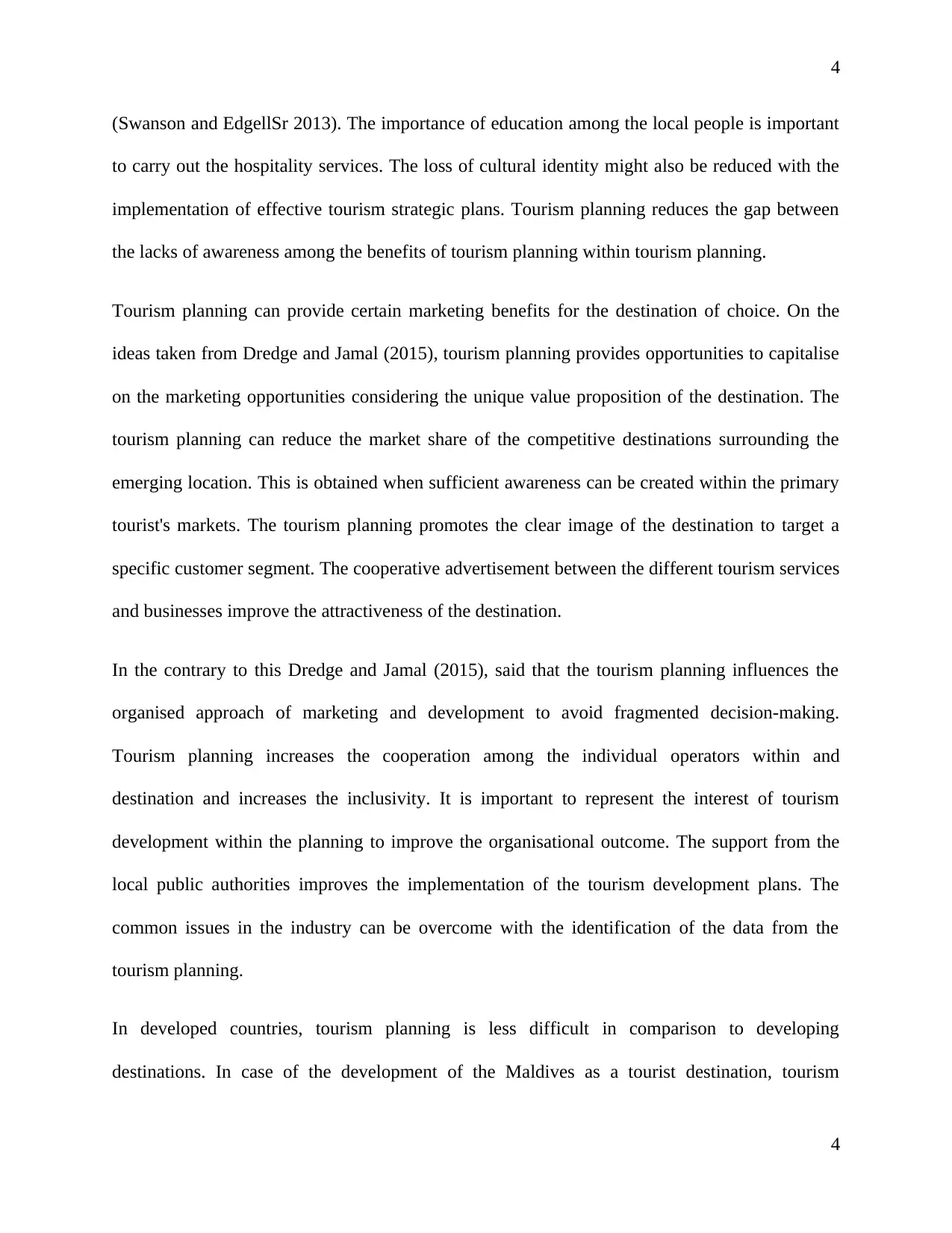
4
(Swanson and EdgellSr 2013). The importance of education among the local people is important
to carry out the hospitality services. The loss of cultural identity might also be reduced with the
implementation of effective tourism strategic plans. Tourism planning reduces the gap between
the lacks of awareness among the benefits of tourism planning within tourism planning.
Tourism planning can provide certain marketing benefits for the destination of choice. On the
ideas taken from Dredge and Jamal (2015), tourism planning provides opportunities to capitalise
on the marketing opportunities considering the unique value proposition of the destination. The
tourism planning can reduce the market share of the competitive destinations surrounding the
emerging location. This is obtained when sufficient awareness can be created within the primary
tourist's markets. The tourism planning promotes the clear image of the destination to target a
specific customer segment. The cooperative advertisement between the different tourism services
and businesses improve the attractiveness of the destination.
In the contrary to this Dredge and Jamal (2015), said that the tourism planning influences the
organised approach of marketing and development to avoid fragmented decision-making.
Tourism planning increases the cooperation among the individual operators within and
destination and increases the inclusivity. It is important to represent the interest of tourism
development within the planning to improve the organisational outcome. The support from the
local public authorities improves the implementation of the tourism development plans. The
common issues in the industry can be overcome with the identification of the data from the
tourism planning.
In developed countries, tourism planning is less difficult in comparison to developing
destinations. In case of the development of the Maldives as a tourist destination, tourism
4
(Swanson and EdgellSr 2013). The importance of education among the local people is important
to carry out the hospitality services. The loss of cultural identity might also be reduced with the
implementation of effective tourism strategic plans. Tourism planning reduces the gap between
the lacks of awareness among the benefits of tourism planning within tourism planning.
Tourism planning can provide certain marketing benefits for the destination of choice. On the
ideas taken from Dredge and Jamal (2015), tourism planning provides opportunities to capitalise
on the marketing opportunities considering the unique value proposition of the destination. The
tourism planning can reduce the market share of the competitive destinations surrounding the
emerging location. This is obtained when sufficient awareness can be created within the primary
tourist's markets. The tourism planning promotes the clear image of the destination to target a
specific customer segment. The cooperative advertisement between the different tourism services
and businesses improve the attractiveness of the destination.
In the contrary to this Dredge and Jamal (2015), said that the tourism planning influences the
organised approach of marketing and development to avoid fragmented decision-making.
Tourism planning increases the cooperation among the individual operators within and
destination and increases the inclusivity. It is important to represent the interest of tourism
development within the planning to improve the organisational outcome. The support from the
local public authorities improves the implementation of the tourism development plans. The
common issues in the industry can be overcome with the identification of the data from the
tourism planning.
In developed countries, tourism planning is less difficult in comparison to developing
destinations. In case of the development of the Maldives as a tourist destination, tourism
4
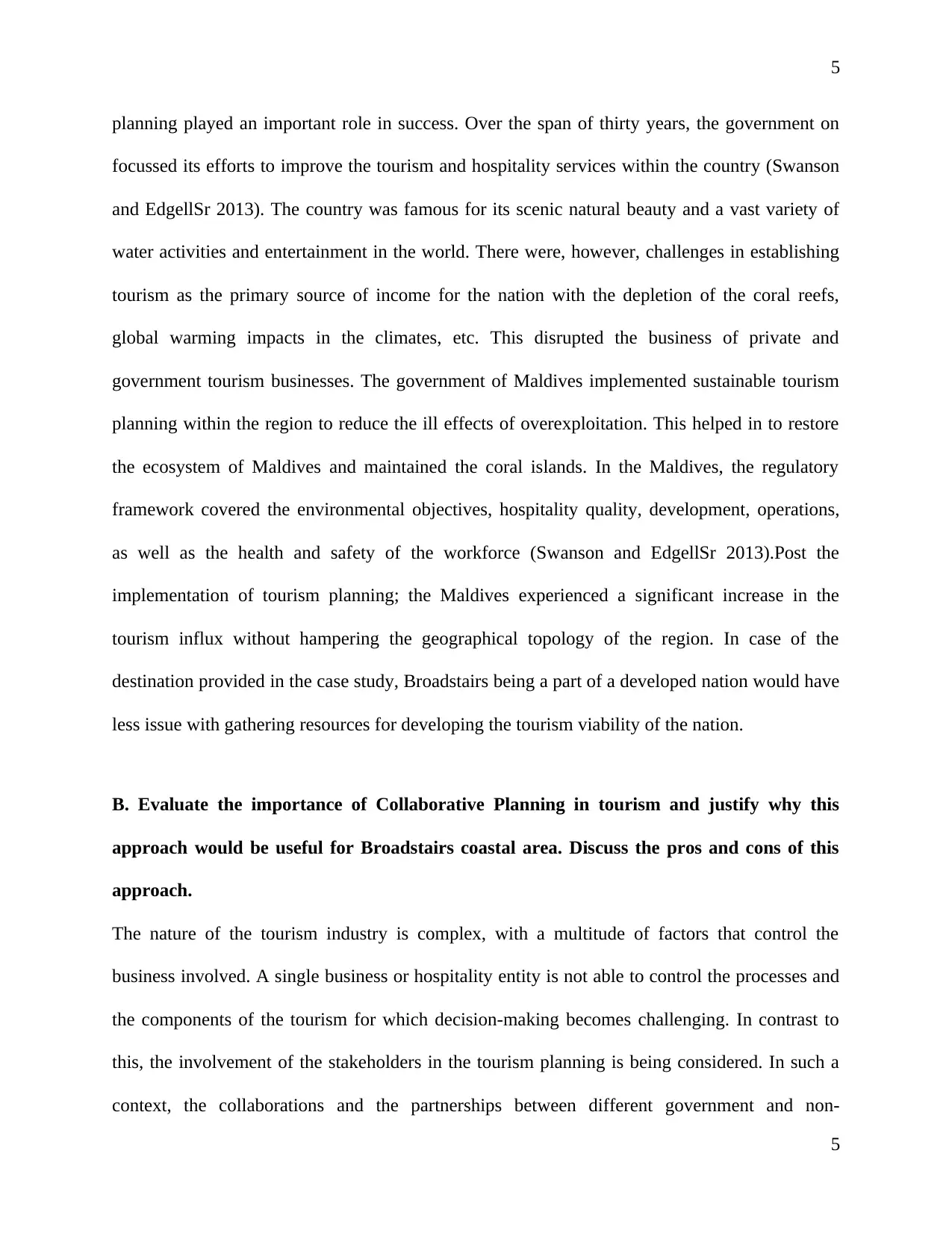
5
planning played an important role in success. Over the span of thirty years, the government on
focussed its efforts to improve the tourism and hospitality services within the country (Swanson
and EdgellSr 2013). The country was famous for its scenic natural beauty and a vast variety of
water activities and entertainment in the world. There were, however, challenges in establishing
tourism as the primary source of income for the nation with the depletion of the coral reefs,
global warming impacts in the climates, etc. This disrupted the business of private and
government tourism businesses. The government of Maldives implemented sustainable tourism
planning within the region to reduce the ill effects of overexploitation. This helped in to restore
the ecosystem of Maldives and maintained the coral islands. In the Maldives, the regulatory
framework covered the environmental objectives, hospitality quality, development, operations,
as well as the health and safety of the workforce (Swanson and EdgellSr 2013).Post the
implementation of tourism planning; the Maldives experienced a significant increase in the
tourism influx without hampering the geographical topology of the region. In case of the
destination provided in the case study, Broadstairs being a part of a developed nation would have
less issue with gathering resources for developing the tourism viability of the nation.
B. Evaluate the importance of Collaborative Planning in tourism and justify why this
approach would be useful for Broadstairs coastal area. Discuss the pros and cons of this
approach.
The nature of the tourism industry is complex, with a multitude of factors that control the
business involved. A single business or hospitality entity is not able to control the processes and
the components of the tourism for which decision-making becomes challenging. In contrast to
this, the involvement of the stakeholders in the tourism planning is being considered. In such a
context, the collaborations and the partnerships between different government and non-
5
planning played an important role in success. Over the span of thirty years, the government on
focussed its efforts to improve the tourism and hospitality services within the country (Swanson
and EdgellSr 2013). The country was famous for its scenic natural beauty and a vast variety of
water activities and entertainment in the world. There were, however, challenges in establishing
tourism as the primary source of income for the nation with the depletion of the coral reefs,
global warming impacts in the climates, etc. This disrupted the business of private and
government tourism businesses. The government of Maldives implemented sustainable tourism
planning within the region to reduce the ill effects of overexploitation. This helped in to restore
the ecosystem of Maldives and maintained the coral islands. In the Maldives, the regulatory
framework covered the environmental objectives, hospitality quality, development, operations,
as well as the health and safety of the workforce (Swanson and EdgellSr 2013).Post the
implementation of tourism planning; the Maldives experienced a significant increase in the
tourism influx without hampering the geographical topology of the region. In case of the
destination provided in the case study, Broadstairs being a part of a developed nation would have
less issue with gathering resources for developing the tourism viability of the nation.
B. Evaluate the importance of Collaborative Planning in tourism and justify why this
approach would be useful for Broadstairs coastal area. Discuss the pros and cons of this
approach.
The nature of the tourism industry is complex, with a multitude of factors that control the
business involved. A single business or hospitality entity is not able to control the processes and
the components of the tourism for which decision-making becomes challenging. In contrast to
this, the involvement of the stakeholders in the tourism planning is being considered. In such a
context, the collaborations and the partnerships between different government and non-
5
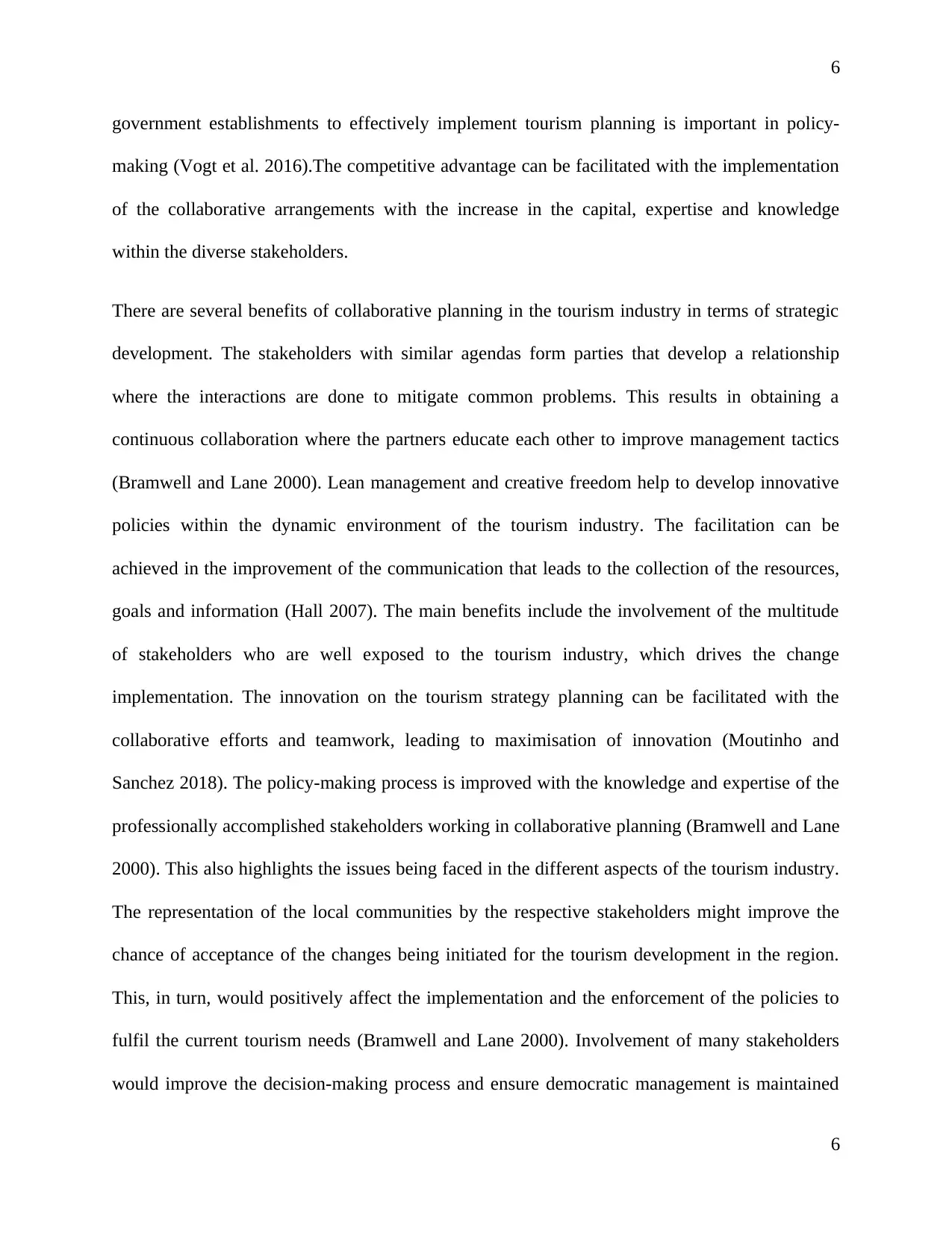
6
government establishments to effectively implement tourism planning is important in policy-
making (Vogt et al. 2016).The competitive advantage can be facilitated with the implementation
of the collaborative arrangements with the increase in the capital, expertise and knowledge
within the diverse stakeholders.
There are several benefits of collaborative planning in the tourism industry in terms of strategic
development. The stakeholders with similar agendas form parties that develop a relationship
where the interactions are done to mitigate common problems. This results in obtaining a
continuous collaboration where the partners educate each other to improve management tactics
(Bramwell and Lane 2000). Lean management and creative freedom help to develop innovative
policies within the dynamic environment of the tourism industry. The facilitation can be
achieved in the improvement of the communication that leads to the collection of the resources,
goals and information (Hall 2007). The main benefits include the involvement of the multitude
of stakeholders who are well exposed to the tourism industry, which drives the change
implementation. The innovation on the tourism strategy planning can be facilitated with the
collaborative efforts and teamwork, leading to maximisation of innovation (Moutinho and
Sanchez 2018). The policy-making process is improved with the knowledge and expertise of the
professionally accomplished stakeholders working in collaborative planning (Bramwell and Lane
2000). This also highlights the issues being faced in the different aspects of the tourism industry.
The representation of the local communities by the respective stakeholders might improve the
chance of acceptance of the changes being initiated for the tourism development in the region.
This, in turn, would positively affect the implementation and the enforcement of the policies to
fulfil the current tourism needs (Bramwell and Lane 2000). Involvement of many stakeholders
would improve the decision-making process and ensure democratic management is maintained
6
government establishments to effectively implement tourism planning is important in policy-
making (Vogt et al. 2016).The competitive advantage can be facilitated with the implementation
of the collaborative arrangements with the increase in the capital, expertise and knowledge
within the diverse stakeholders.
There are several benefits of collaborative planning in the tourism industry in terms of strategic
development. The stakeholders with similar agendas form parties that develop a relationship
where the interactions are done to mitigate common problems. This results in obtaining a
continuous collaboration where the partners educate each other to improve management tactics
(Bramwell and Lane 2000). Lean management and creative freedom help to develop innovative
policies within the dynamic environment of the tourism industry. The facilitation can be
achieved in the improvement of the communication that leads to the collection of the resources,
goals and information (Hall 2007). The main benefits include the involvement of the multitude
of stakeholders who are well exposed to the tourism industry, which drives the change
implementation. The innovation on the tourism strategy planning can be facilitated with the
collaborative efforts and teamwork, leading to maximisation of innovation (Moutinho and
Sanchez 2018). The policy-making process is improved with the knowledge and expertise of the
professionally accomplished stakeholders working in collaborative planning (Bramwell and Lane
2000). This also highlights the issues being faced in the different aspects of the tourism industry.
The representation of the local communities by the respective stakeholders might improve the
chance of acceptance of the changes being initiated for the tourism development in the region.
This, in turn, would positively affect the implementation and the enforcement of the policies to
fulfil the current tourism needs (Bramwell and Lane 2000). Involvement of many stakeholders
would improve the decision-making process and ensure democratic management is maintained
6
Paraphrase This Document
Need a fresh take? Get an instant paraphrase of this document with our AI Paraphraser
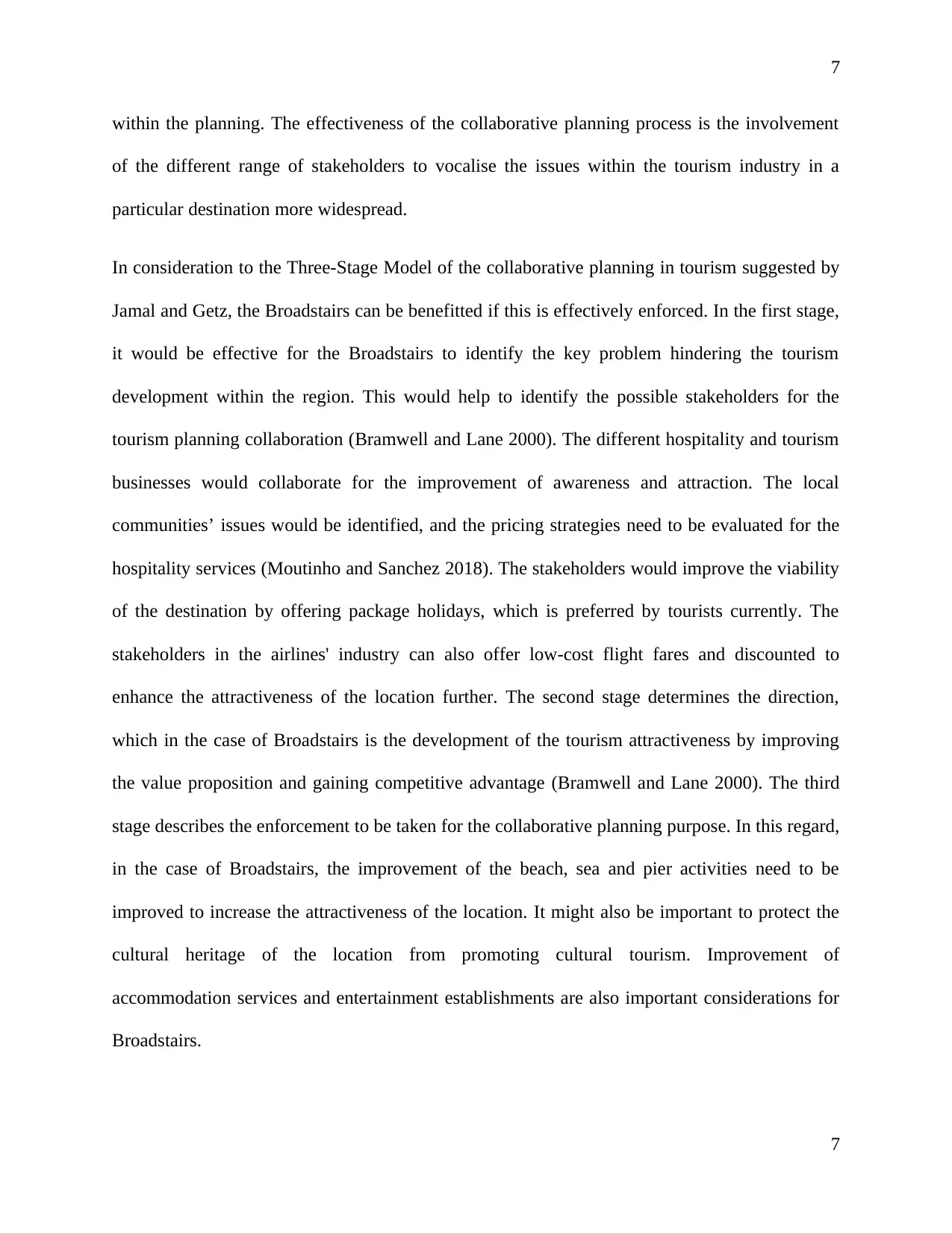
7
within the planning. The effectiveness of the collaborative planning process is the involvement
of the different range of stakeholders to vocalise the issues within the tourism industry in a
particular destination more widespread.
In consideration to the Three-Stage Model of the collaborative planning in tourism suggested by
Jamal and Getz, the Broadstairs can be benefitted if this is effectively enforced. In the first stage,
it would be effective for the Broadstairs to identify the key problem hindering the tourism
development within the region. This would help to identify the possible stakeholders for the
tourism planning collaboration (Bramwell and Lane 2000). The different hospitality and tourism
businesses would collaborate for the improvement of awareness and attraction. The local
communities’ issues would be identified, and the pricing strategies need to be evaluated for the
hospitality services (Moutinho and Sanchez 2018). The stakeholders would improve the viability
of the destination by offering package holidays, which is preferred by tourists currently. The
stakeholders in the airlines' industry can also offer low-cost flight fares and discounted to
enhance the attractiveness of the location further. The second stage determines the direction,
which in the case of Broadstairs is the development of the tourism attractiveness by improving
the value proposition and gaining competitive advantage (Bramwell and Lane 2000). The third
stage describes the enforcement to be taken for the collaborative planning purpose. In this regard,
in the case of Broadstairs, the improvement of the beach, sea and pier activities need to be
improved to increase the attractiveness of the location. It might also be important to protect the
cultural heritage of the location from promoting cultural tourism. Improvement of
accommodation services and entertainment establishments are also important considerations for
Broadstairs.
7
within the planning. The effectiveness of the collaborative planning process is the involvement
of the different range of stakeholders to vocalise the issues within the tourism industry in a
particular destination more widespread.
In consideration to the Three-Stage Model of the collaborative planning in tourism suggested by
Jamal and Getz, the Broadstairs can be benefitted if this is effectively enforced. In the first stage,
it would be effective for the Broadstairs to identify the key problem hindering the tourism
development within the region. This would help to identify the possible stakeholders for the
tourism planning collaboration (Bramwell and Lane 2000). The different hospitality and tourism
businesses would collaborate for the improvement of awareness and attraction. The local
communities’ issues would be identified, and the pricing strategies need to be evaluated for the
hospitality services (Moutinho and Sanchez 2018). The stakeholders would improve the viability
of the destination by offering package holidays, which is preferred by tourists currently. The
stakeholders in the airlines' industry can also offer low-cost flight fares and discounted to
enhance the attractiveness of the location further. The second stage determines the direction,
which in the case of Broadstairs is the development of the tourism attractiveness by improving
the value proposition and gaining competitive advantage (Bramwell and Lane 2000). The third
stage describes the enforcement to be taken for the collaborative planning purpose. In this regard,
in the case of Broadstairs, the improvement of the beach, sea and pier activities need to be
improved to increase the attractiveness of the location. It might also be important to protect the
cultural heritage of the location from promoting cultural tourism. Improvement of
accommodation services and entertainment establishments are also important considerations for
Broadstairs.
7
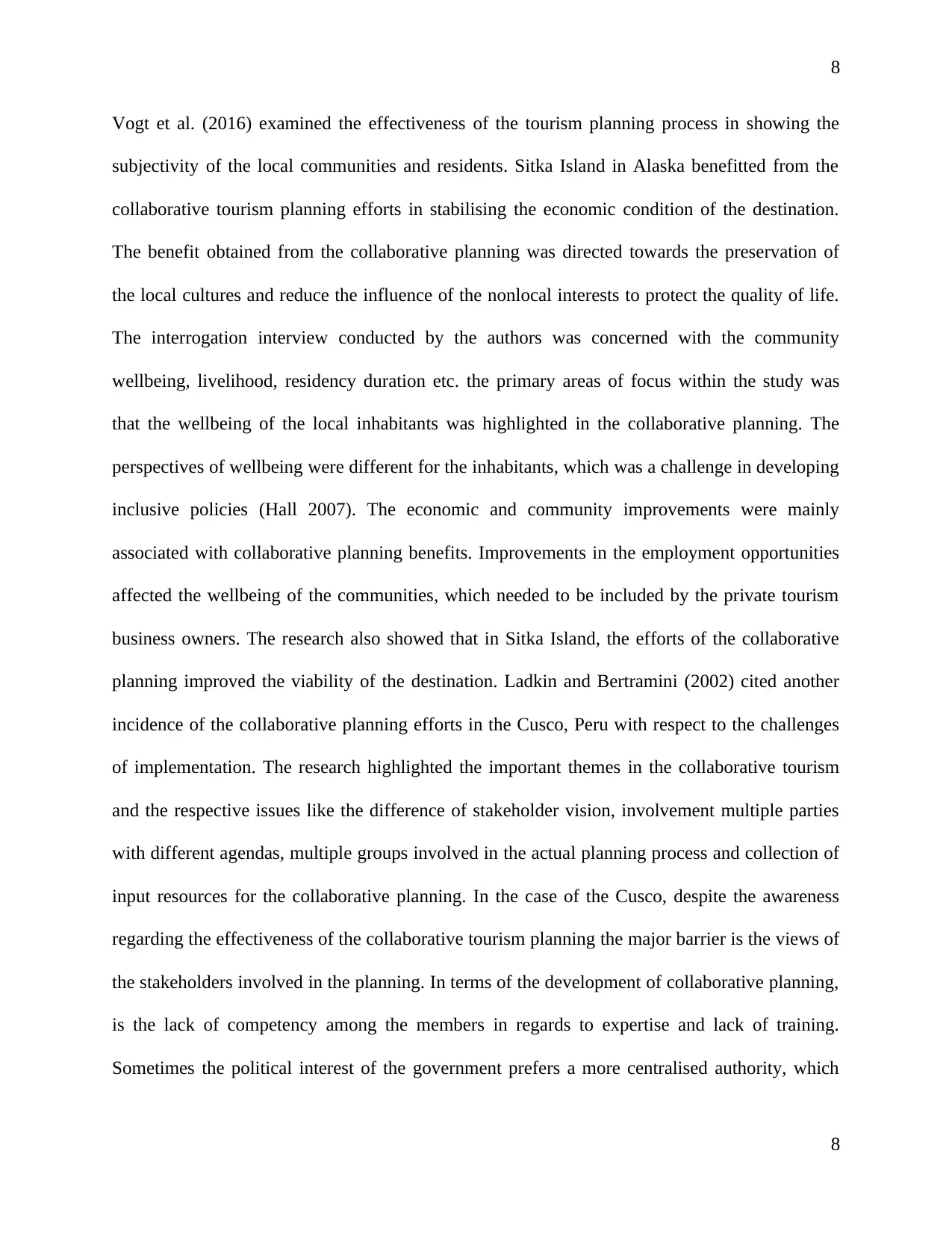
8
Vogt et al. (2016) examined the effectiveness of the tourism planning process in showing the
subjectivity of the local communities and residents. Sitka Island in Alaska benefitted from the
collaborative tourism planning efforts in stabilising the economic condition of the destination.
The benefit obtained from the collaborative planning was directed towards the preservation of
the local cultures and reduce the influence of the nonlocal interests to protect the quality of life.
The interrogation interview conducted by the authors was concerned with the community
wellbeing, livelihood, residency duration etc. the primary areas of focus within the study was
that the wellbeing of the local inhabitants was highlighted in the collaborative planning. The
perspectives of wellbeing were different for the inhabitants, which was a challenge in developing
inclusive policies (Hall 2007). The economic and community improvements were mainly
associated with collaborative planning benefits. Improvements in the employment opportunities
affected the wellbeing of the communities, which needed to be included by the private tourism
business owners. The research also showed that in Sitka Island, the efforts of the collaborative
planning improved the viability of the destination. Ladkin and Bertramini (2002) cited another
incidence of the collaborative planning efforts in the Cusco, Peru with respect to the challenges
of implementation. The research highlighted the important themes in the collaborative tourism
and the respective issues like the difference of stakeholder vision, involvement multiple parties
with different agendas, multiple groups involved in the actual planning process and collection of
input resources for the collaborative planning. In the case of the Cusco, despite the awareness
regarding the effectiveness of the collaborative tourism planning the major barrier is the views of
the stakeholders involved in the planning. In terms of the development of collaborative planning,
is the lack of competency among the members in regards to expertise and lack of training.
Sometimes the political interest of the government prefers a more centralised authority, which
8
Vogt et al. (2016) examined the effectiveness of the tourism planning process in showing the
subjectivity of the local communities and residents. Sitka Island in Alaska benefitted from the
collaborative tourism planning efforts in stabilising the economic condition of the destination.
The benefit obtained from the collaborative planning was directed towards the preservation of
the local cultures and reduce the influence of the nonlocal interests to protect the quality of life.
The interrogation interview conducted by the authors was concerned with the community
wellbeing, livelihood, residency duration etc. the primary areas of focus within the study was
that the wellbeing of the local inhabitants was highlighted in the collaborative planning. The
perspectives of wellbeing were different for the inhabitants, which was a challenge in developing
inclusive policies (Hall 2007). The economic and community improvements were mainly
associated with collaborative planning benefits. Improvements in the employment opportunities
affected the wellbeing of the communities, which needed to be included by the private tourism
business owners. The research also showed that in Sitka Island, the efforts of the collaborative
planning improved the viability of the destination. Ladkin and Bertramini (2002) cited another
incidence of the collaborative planning efforts in the Cusco, Peru with respect to the challenges
of implementation. The research highlighted the important themes in the collaborative tourism
and the respective issues like the difference of stakeholder vision, involvement multiple parties
with different agendas, multiple groups involved in the actual planning process and collection of
input resources for the collaborative planning. In the case of the Cusco, despite the awareness
regarding the effectiveness of the collaborative tourism planning the major barrier is the views of
the stakeholders involved in the planning. In terms of the development of collaborative planning,
is the lack of competency among the members in regards to expertise and lack of training.
Sometimes the political interest of the government prefers a more centralised authority, which
8
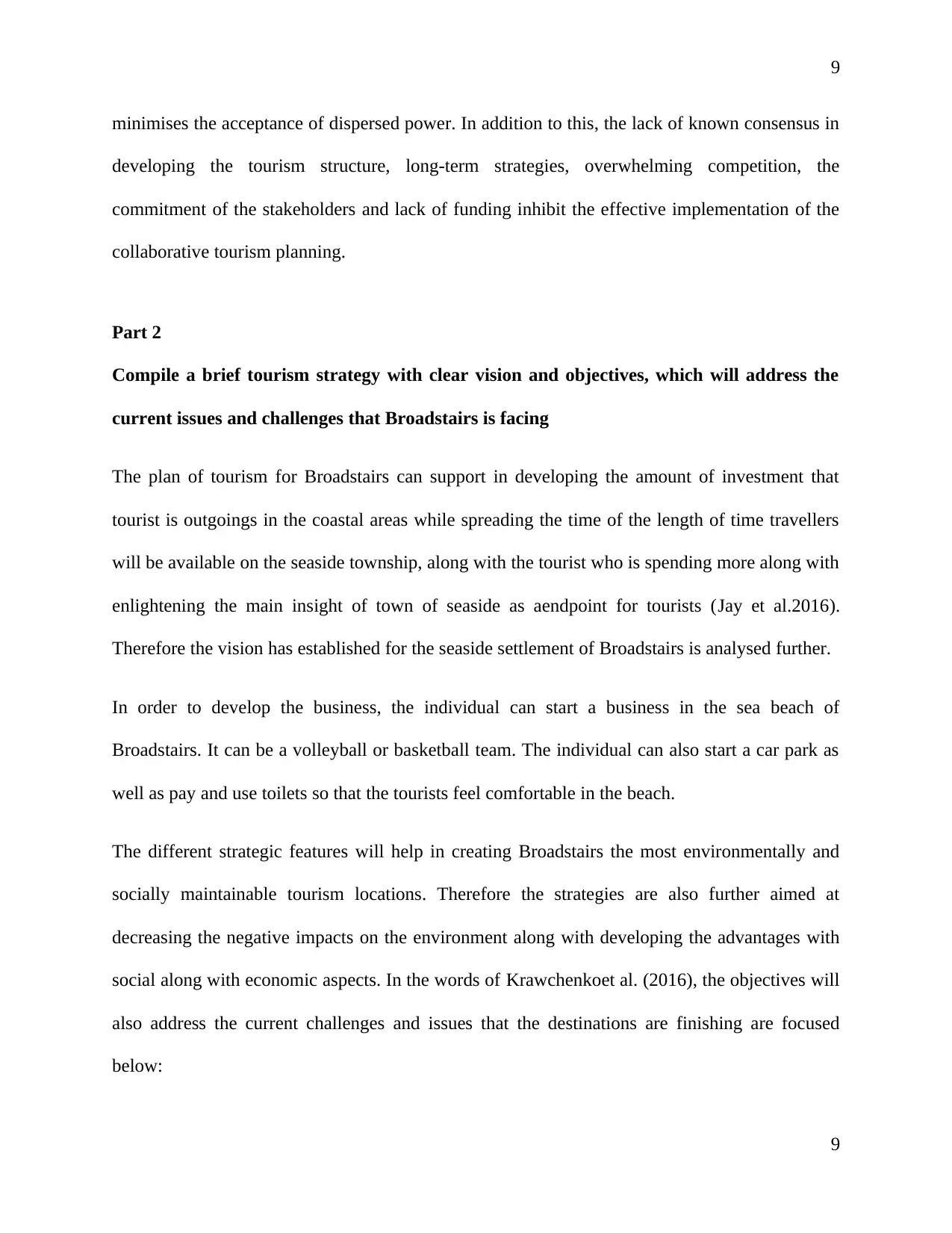
9
minimises the acceptance of dispersed power. In addition to this, the lack of known consensus in
developing the tourism structure, long-term strategies, overwhelming competition, the
commitment of the stakeholders and lack of funding inhibit the effective implementation of the
collaborative tourism planning.
Part 2
Compile a brief tourism strategy with clear vision and objectives, which will address the
current issues and challenges that Broadstairs is facing
The plan of tourism for Broadstairs can support in developing the amount of investment that
tourist is outgoings in the coastal areas while spreading the time of the length of time travellers
will be available on the seaside township, along with the tourist who is spending more along with
enlightening the main insight of town of seaside as aendpoint for tourists (Jay et al.2016).
Therefore the vision has established for the seaside settlement of Broadstairs is analysed further.
In order to develop the business, the individual can start a business in the sea beach of
Broadstairs. It can be a volleyball or basketball team. The individual can also start a car park as
well as pay and use toilets so that the tourists feel comfortable in the beach.
The different strategic features will help in creating Broadstairs the most environmentally and
socially maintainable tourism locations. Therefore the strategies are also further aimed at
decreasing the negative impacts on the environment along with developing the advantages with
social along with economic aspects. In the words of Krawchenkoet al. (2016), the objectives will
also address the current challenges and issues that the destinations are finishing are focused
below:
9
minimises the acceptance of dispersed power. In addition to this, the lack of known consensus in
developing the tourism structure, long-term strategies, overwhelming competition, the
commitment of the stakeholders and lack of funding inhibit the effective implementation of the
collaborative tourism planning.
Part 2
Compile a brief tourism strategy with clear vision and objectives, which will address the
current issues and challenges that Broadstairs is facing
The plan of tourism for Broadstairs can support in developing the amount of investment that
tourist is outgoings in the coastal areas while spreading the time of the length of time travellers
will be available on the seaside township, along with the tourist who is spending more along with
enlightening the main insight of town of seaside as aendpoint for tourists (Jay et al.2016).
Therefore the vision has established for the seaside settlement of Broadstairs is analysed further.
In order to develop the business, the individual can start a business in the sea beach of
Broadstairs. It can be a volleyball or basketball team. The individual can also start a car park as
well as pay and use toilets so that the tourists feel comfortable in the beach.
The different strategic features will help in creating Broadstairs the most environmentally and
socially maintainable tourism locations. Therefore the strategies are also further aimed at
decreasing the negative impacts on the environment along with developing the advantages with
social along with economic aspects. In the words of Krawchenkoet al. (2016), the objectives will
also address the current challenges and issues that the destinations are finishing are focused
below:
9
Secure Best Marks with AI Grader
Need help grading? Try our AI Grader for instant feedback on your assignments.
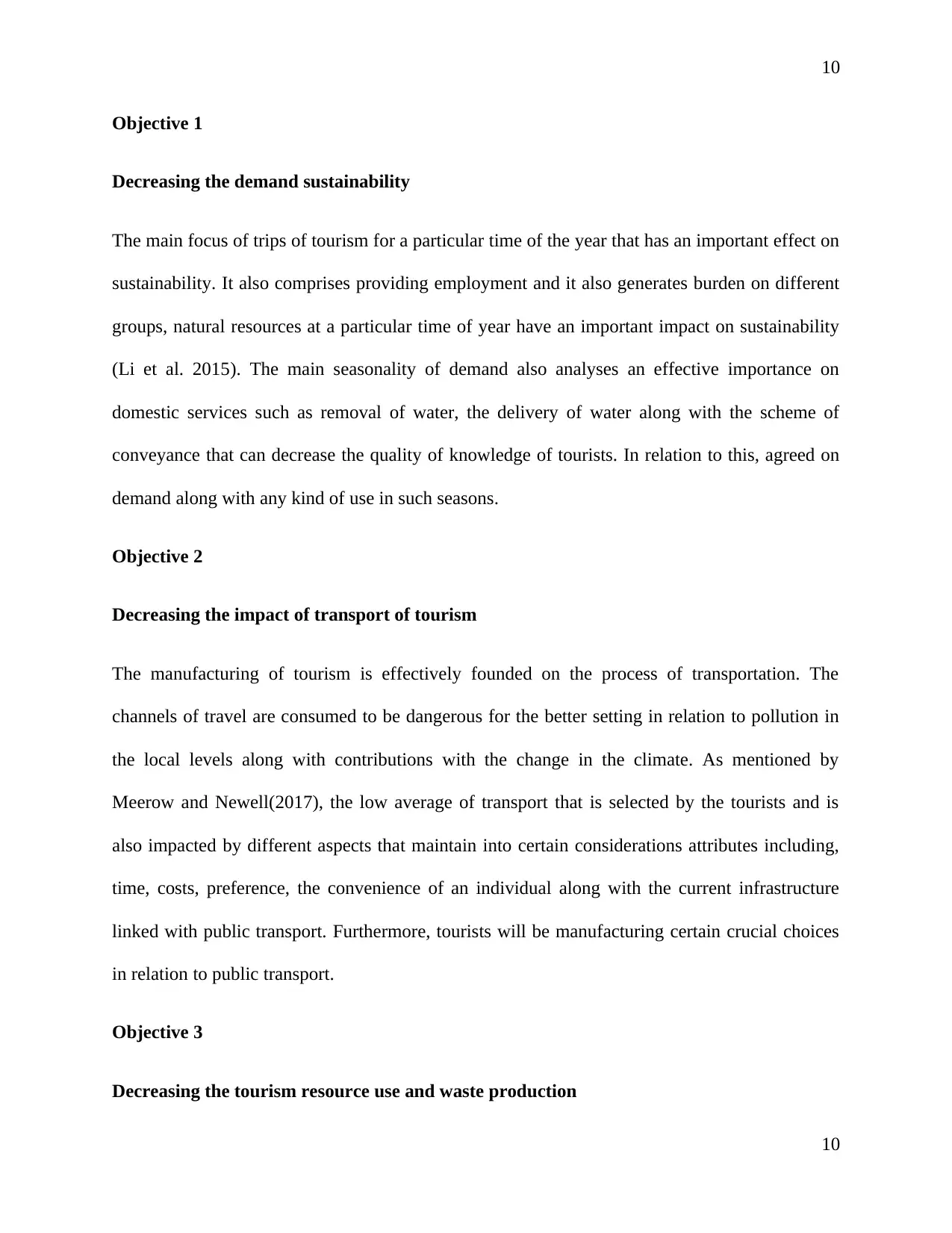
10
Objective 1
Decreasing the demand sustainability
The main focus of trips of tourism for a particular time of the year that has an important effect on
sustainability. It also comprises providing employment and it also generates burden on different
groups, natural resources at a particular time of year have an important impact on sustainability
(Li et al. 2015). The main seasonality of demand also analyses an effective importance on
domestic services such as removal of water, the delivery of water along with the scheme of
conveyance that can decrease the quality of knowledge of tourists. In relation to this, agreed on
demand along with any kind of use in such seasons.
Objective 2
Decreasing the impact of transport of tourism
The manufacturing of tourism is effectively founded on the process of transportation. The
channels of travel are consumed to be dangerous for the better setting in relation to pollution in
the local levels along with contributions with the change in the climate. As mentioned by
Meerow and Newell(2017), the low average of transport that is selected by the tourists and is
also impacted by different aspects that maintain into certain considerations attributes including,
time, costs, preference, the convenience of an individual along with the current infrastructure
linked with public transport. Furthermore, tourists will be manufacturing certain crucial choices
in relation to public transport.
Objective 3
Decreasing the tourism resource use and waste production
10
Objective 1
Decreasing the demand sustainability
The main focus of trips of tourism for a particular time of the year that has an important effect on
sustainability. It also comprises providing employment and it also generates burden on different
groups, natural resources at a particular time of year have an important impact on sustainability
(Li et al. 2015). The main seasonality of demand also analyses an effective importance on
domestic services such as removal of water, the delivery of water along with the scheme of
conveyance that can decrease the quality of knowledge of tourists. In relation to this, agreed on
demand along with any kind of use in such seasons.
Objective 2
Decreasing the impact of transport of tourism
The manufacturing of tourism is effectively founded on the process of transportation. The
channels of travel are consumed to be dangerous for the better setting in relation to pollution in
the local levels along with contributions with the change in the climate. As mentioned by
Meerow and Newell(2017), the low average of transport that is selected by the tourists and is
also impacted by different aspects that maintain into certain considerations attributes including,
time, costs, preference, the convenience of an individual along with the current infrastructure
linked with public transport. Furthermore, tourists will be manufacturing certain crucial choices
in relation to public transport.
Objective 3
Decreasing the tourism resource use and waste production
10
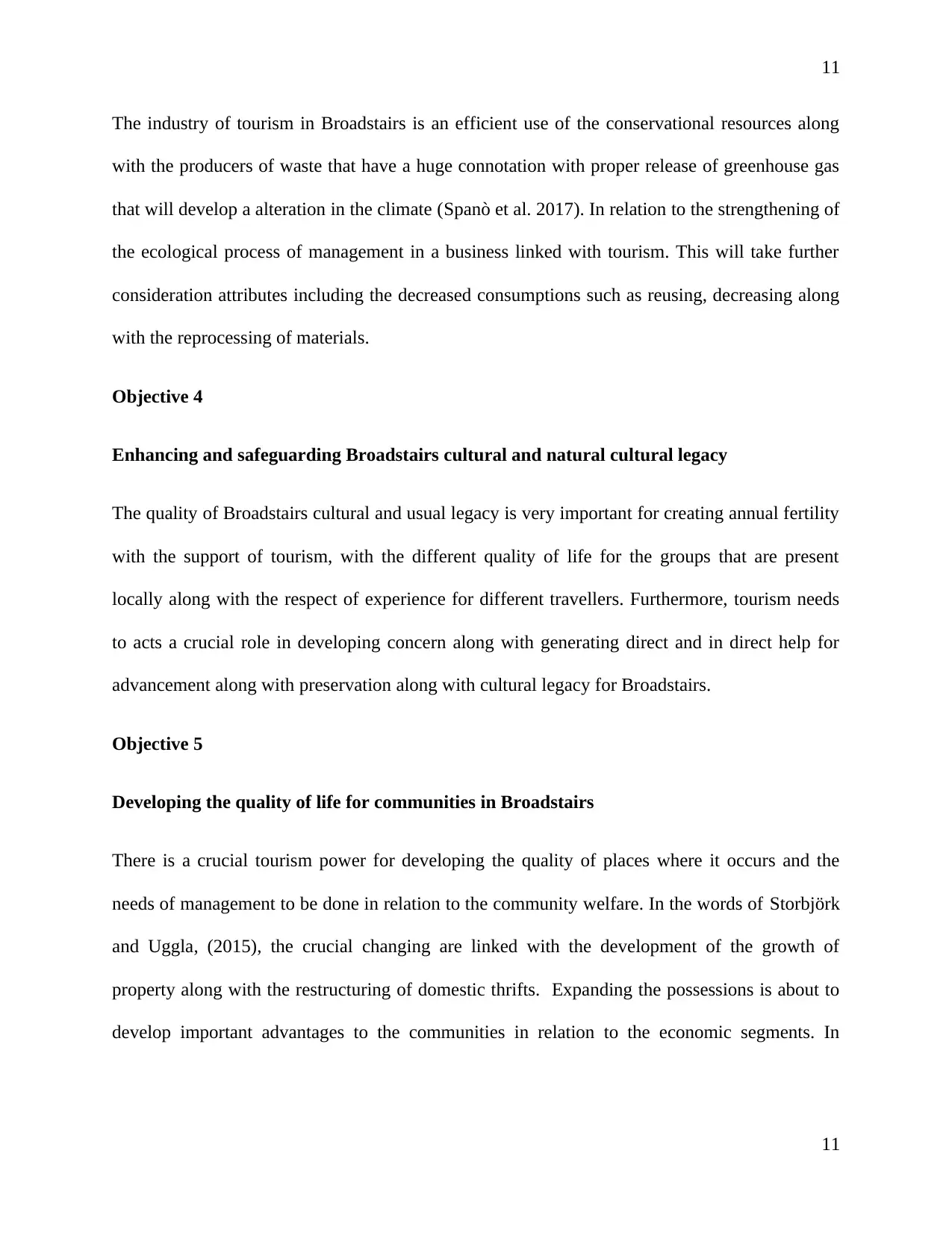
11
The industry of tourism in Broadstairs is an efficient use of the conservational resources along
with the producers of waste that have a huge connotation with proper release of greenhouse gas
that will develop a alteration in the climate (Spanò et al. 2017). In relation to the strengthening of
the ecological process of management in a business linked with tourism. This will take further
consideration attributes including the decreased consumptions such as reusing, decreasing along
with the reprocessing of materials.
Objective 4
Enhancing and safeguarding Broadstairs cultural and natural cultural legacy
The quality of Broadstairs cultural and usual legacy is very important for creating annual fertility
with the support of tourism, with the different quality of life for the groups that are present
locally along with the respect of experience for different travellers. Furthermore, tourism needs
to acts a crucial role in developing concern along with generating direct and in direct help for
advancement along with preservation along with cultural legacy for Broadstairs.
Objective 5
Developing the quality of life for communities in Broadstairs
There is a crucial tourism power for developing the quality of places where it occurs and the
needs of management to be done in relation to the community welfare. In the words of Storbjörk
and Uggla, (2015), the crucial changing are linked with the development of the growth of
property along with the restructuring of domestic thrifts. Expanding the possessions is about to
develop important advantages to the communities in relation to the economic segments. In
11
The industry of tourism in Broadstairs is an efficient use of the conservational resources along
with the producers of waste that have a huge connotation with proper release of greenhouse gas
that will develop a alteration in the climate (Spanò et al. 2017). In relation to the strengthening of
the ecological process of management in a business linked with tourism. This will take further
consideration attributes including the decreased consumptions such as reusing, decreasing along
with the reprocessing of materials.
Objective 4
Enhancing and safeguarding Broadstairs cultural and natural cultural legacy
The quality of Broadstairs cultural and usual legacy is very important for creating annual fertility
with the support of tourism, with the different quality of life for the groups that are present
locally along with the respect of experience for different travellers. Furthermore, tourism needs
to acts a crucial role in developing concern along with generating direct and in direct help for
advancement along with preservation along with cultural legacy for Broadstairs.
Objective 5
Developing the quality of life for communities in Broadstairs
There is a crucial tourism power for developing the quality of places where it occurs and the
needs of management to be done in relation to the community welfare. In the words of Storbjörk
and Uggla, (2015), the crucial changing are linked with the development of the growth of
property along with the restructuring of domestic thrifts. Expanding the possessions is about to
develop important advantages to the communities in relation to the economic segments. In
11
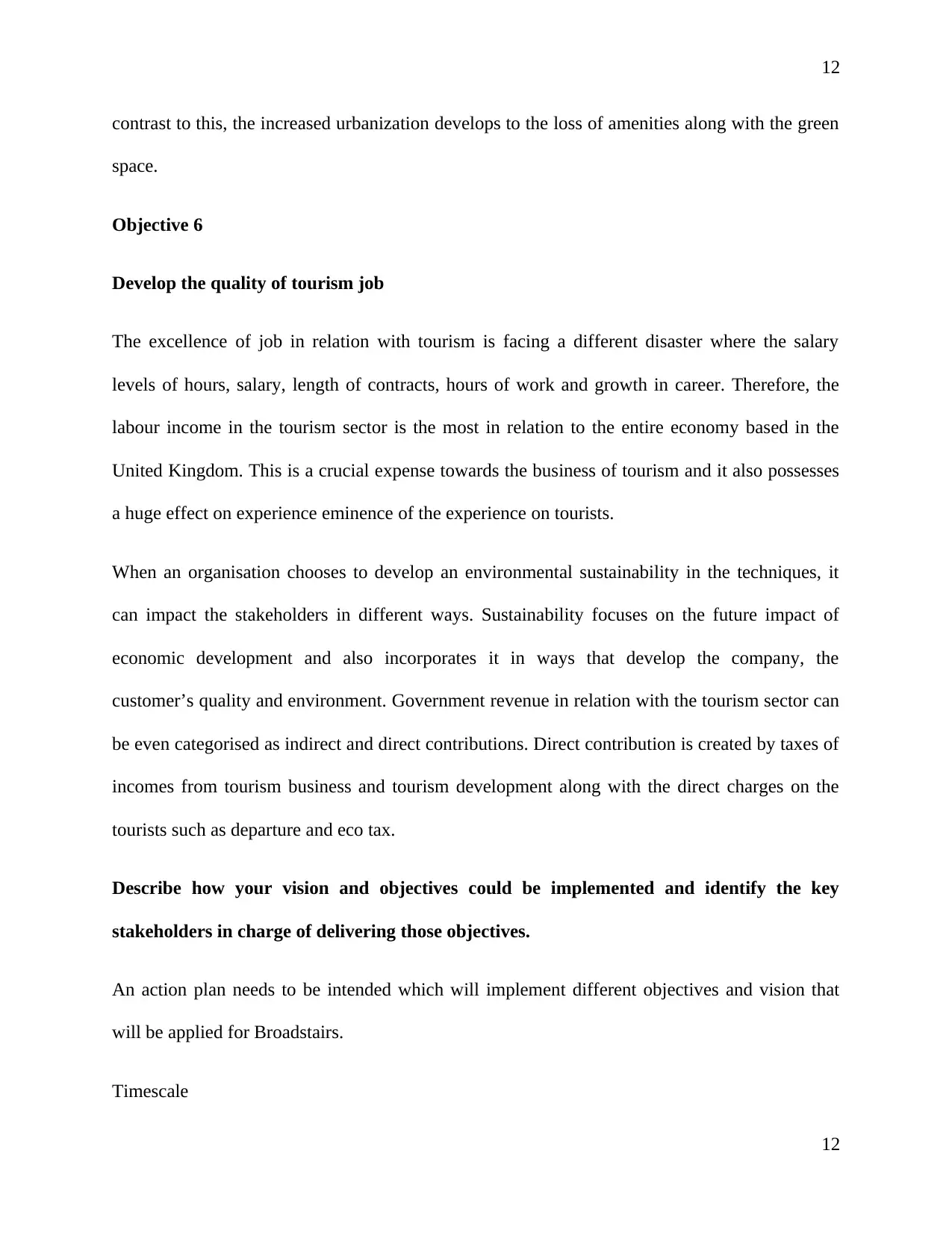
12
contrast to this, the increased urbanization develops to the loss of amenities along with the green
space.
Objective 6
Develop the quality of tourism job
The excellence of job in relation with tourism is facing a different disaster where the salary
levels of hours, salary, length of contracts, hours of work and growth in career. Therefore, the
labour income in the tourism sector is the most in relation to the entire economy based in the
United Kingdom. This is a crucial expense towards the business of tourism and it also possesses
a huge effect on experience eminence of the experience on tourists.
When an organisation chooses to develop an environmental sustainability in the techniques, it
can impact the stakeholders in different ways. Sustainability focuses on the future impact of
economic development and also incorporates it in ways that develop the company, the
customer’s quality and environment. Government revenue in relation with the tourism sector can
be even categorised as indirect and direct contributions. Direct contribution is created by taxes of
incomes from tourism business and tourism development along with the direct charges on the
tourists such as departure and eco tax.
Describe how your vision and objectives could be implemented and identify the key
stakeholders in charge of delivering those objectives.
An action plan needs to be intended which will implement different objectives and vision that
will be applied for Broadstairs.
Timescale
12
contrast to this, the increased urbanization develops to the loss of amenities along with the green
space.
Objective 6
Develop the quality of tourism job
The excellence of job in relation with tourism is facing a different disaster where the salary
levels of hours, salary, length of contracts, hours of work and growth in career. Therefore, the
labour income in the tourism sector is the most in relation to the entire economy based in the
United Kingdom. This is a crucial expense towards the business of tourism and it also possesses
a huge effect on experience eminence of the experience on tourists.
When an organisation chooses to develop an environmental sustainability in the techniques, it
can impact the stakeholders in different ways. Sustainability focuses on the future impact of
economic development and also incorporates it in ways that develop the company, the
customer’s quality and environment. Government revenue in relation with the tourism sector can
be even categorised as indirect and direct contributions. Direct contribution is created by taxes of
incomes from tourism business and tourism development along with the direct charges on the
tourists such as departure and eco tax.
Describe how your vision and objectives could be implemented and identify the key
stakeholders in charge of delivering those objectives.
An action plan needs to be intended which will implement different objectives and vision that
will be applied for Broadstairs.
Timescale
12
Paraphrase This Document
Need a fresh take? Get an instant paraphrase of this document with our AI Paraphraser
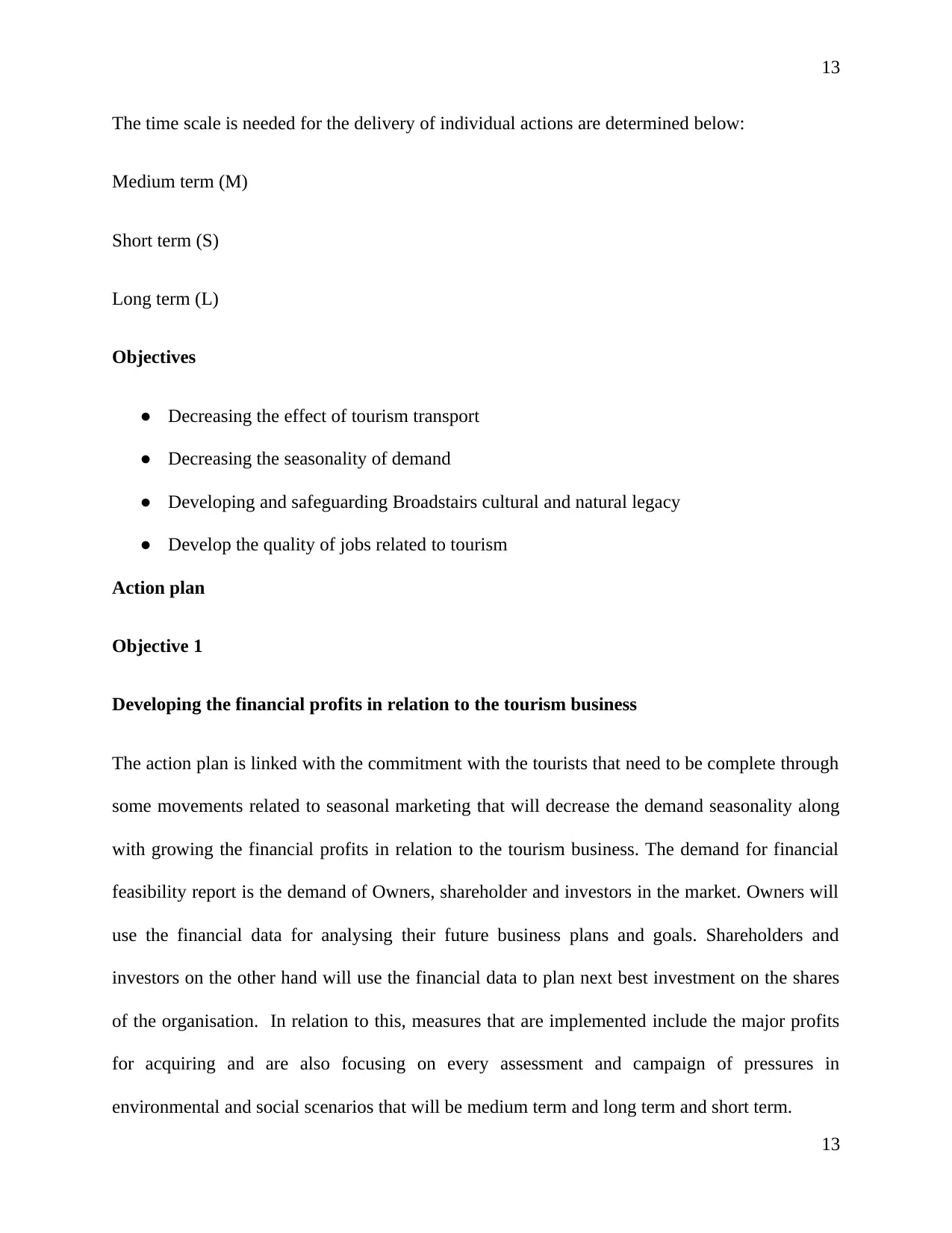
13
The time scale is needed for the delivery of individual actions are determined below:
Medium term (M)
Short term (S)
Long term (L)
Objectives
● Decreasing the effect of tourism transport
● Decreasing the seasonality of demand
● Developing and safeguarding Broadstairs cultural and natural legacy
● Develop the quality of jobs related to tourism
Action plan
Objective 1
Developing the financial profits in relation to the tourism business
The action plan is linked with the commitment with the tourists that need to be complete through
some movements related to seasonal marketing that will decrease the demand seasonality along
with growing the financial profits in relation to the tourism business. The demand for financial
feasibility report is the demand of Owners, shareholder and investors in the market. Owners will
use the financial data for analysing their future business plans and goals. Shareholders and
investors on the other hand will use the financial data to plan next best investment on the shares
of the organisation. In relation to this, measures that are implemented include the major profits
for acquiring and are also focusing on every assessment and campaign of pressures in
environmental and social scenarios that will be medium term and long term and short term.
13
The time scale is needed for the delivery of individual actions are determined below:
Medium term (M)
Short term (S)
Long term (L)
Objectives
● Decreasing the effect of tourism transport
● Decreasing the seasonality of demand
● Developing and safeguarding Broadstairs cultural and natural legacy
● Develop the quality of jobs related to tourism
Action plan
Objective 1
Developing the financial profits in relation to the tourism business
The action plan is linked with the commitment with the tourists that need to be complete through
some movements related to seasonal marketing that will decrease the demand seasonality along
with growing the financial profits in relation to the tourism business. The demand for financial
feasibility report is the demand of Owners, shareholder and investors in the market. Owners will
use the financial data for analysing their future business plans and goals. Shareholders and
investors on the other hand will use the financial data to plan next best investment on the shares
of the organisation. In relation to this, measures that are implemented include the major profits
for acquiring and are also focusing on every assessment and campaign of pressures in
environmental and social scenarios that will be medium term and long term and short term.
13
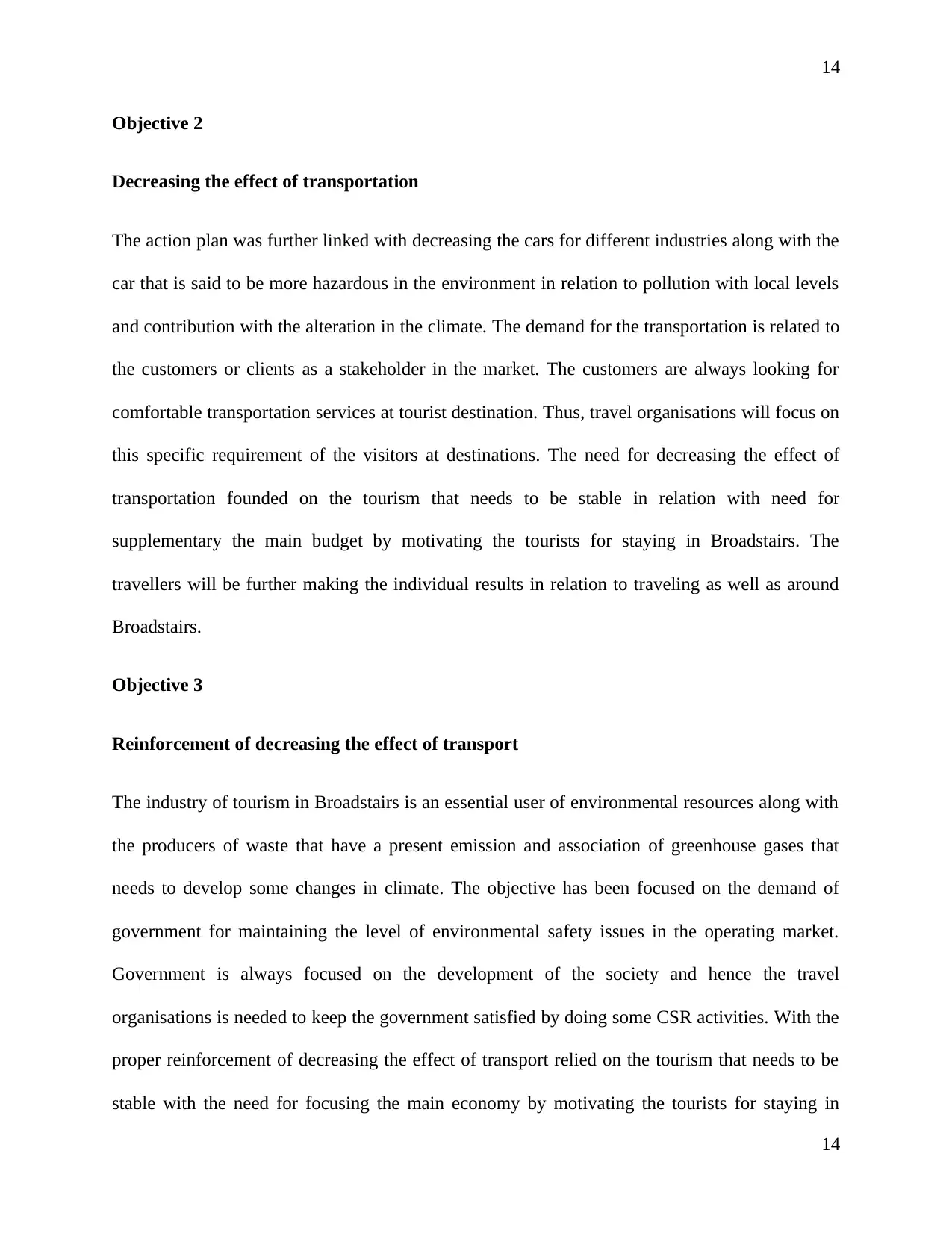
14
Objective 2
Decreasing the effect of transportation
The action plan was further linked with decreasing the cars for different industries along with the
car that is said to be more hazardous in the environment in relation to pollution with local levels
and contribution with the alteration in the climate. The demand for the transportation is related to
the customers or clients as a stakeholder in the market. The customers are always looking for
comfortable transportation services at tourist destination. Thus, travel organisations will focus on
this specific requirement of the visitors at destinations. The need for decreasing the effect of
transportation founded on the tourism that needs to be stable in relation with need for
supplementary the main budget by motivating the tourists for staying in Broadstairs. The
travellers will be further making the individual results in relation to traveling as well as around
Broadstairs.
Objective 3
Reinforcement of decreasing the effect of transport
The industry of tourism in Broadstairs is an essential user of environmental resources along with
the producers of waste that have a present emission and association of greenhouse gases that
needs to develop some changes in climate. The objective has been focused on the demand of
government for maintaining the level of environmental safety issues in the operating market.
Government is always focused on the development of the society and hence the travel
organisations is needed to keep the government satisfied by doing some CSR activities. With the
proper reinforcement of decreasing the effect of transport relied on the tourism that needs to be
stable with the need for focusing the main economy by motivating the tourists for staying in
14
Objective 2
Decreasing the effect of transportation
The action plan was further linked with decreasing the cars for different industries along with the
car that is said to be more hazardous in the environment in relation to pollution with local levels
and contribution with the alteration in the climate. The demand for the transportation is related to
the customers or clients as a stakeholder in the market. The customers are always looking for
comfortable transportation services at tourist destination. Thus, travel organisations will focus on
this specific requirement of the visitors at destinations. The need for decreasing the effect of
transportation founded on the tourism that needs to be stable in relation with need for
supplementary the main budget by motivating the tourists for staying in Broadstairs. The
travellers will be further making the individual results in relation to traveling as well as around
Broadstairs.
Objective 3
Reinforcement of decreasing the effect of transport
The industry of tourism in Broadstairs is an essential user of environmental resources along with
the producers of waste that have a present emission and association of greenhouse gases that
needs to develop some changes in climate. The objective has been focused on the demand of
government for maintaining the level of environmental safety issues in the operating market.
Government is always focused on the development of the society and hence the travel
organisations is needed to keep the government satisfied by doing some CSR activities. With the
proper reinforcement of decreasing the effect of transport relied on the tourism that needs to be
stable with the need for focusing the main economy by motivating the tourists for staying in
14
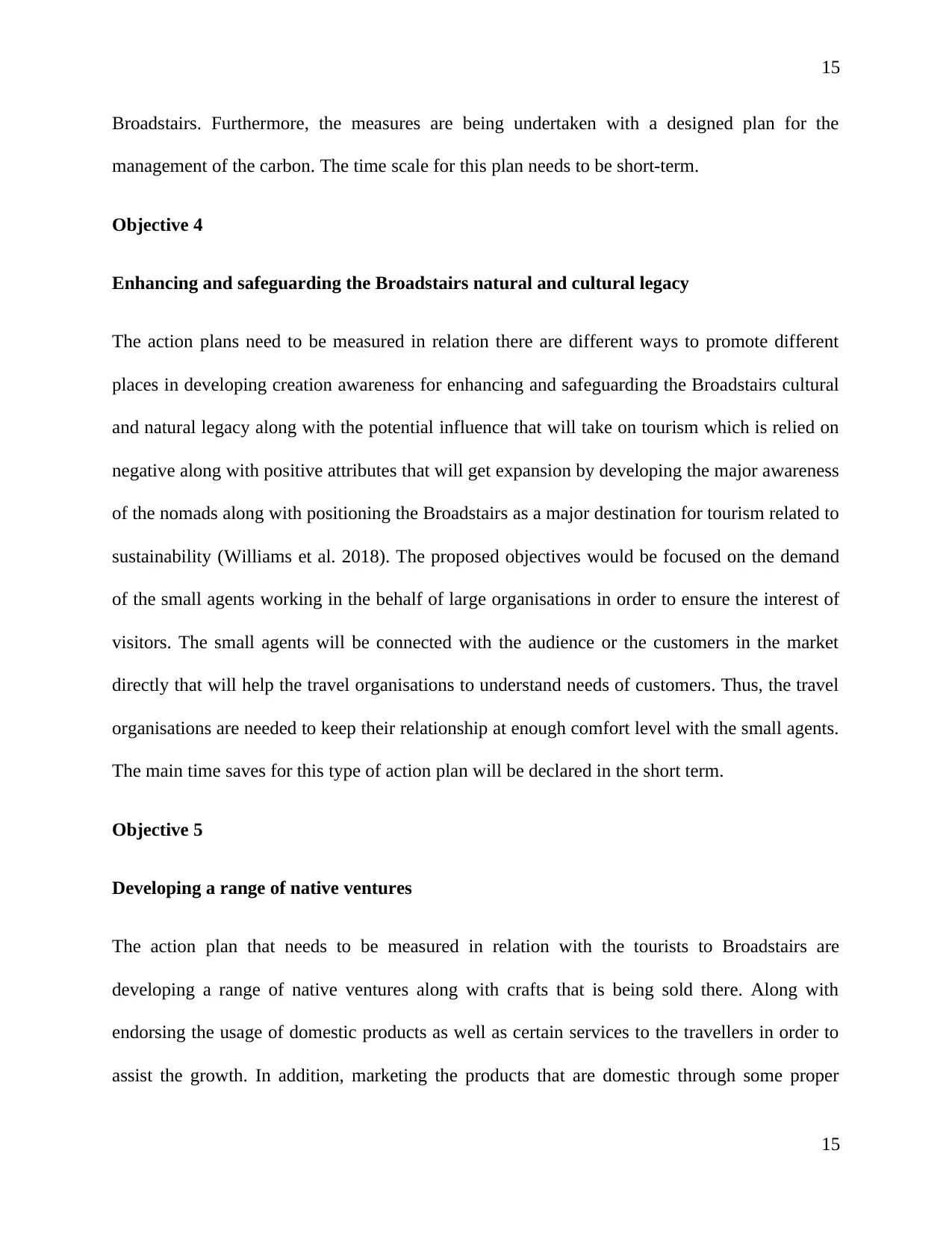
15
Broadstairs. Furthermore, the measures are being undertaken with a designed plan for the
management of the carbon. The time scale for this plan needs to be short-term.
Objective 4
Enhancing and safeguarding the Broadstairs natural and cultural legacy
The action plans need to be measured in relation there are different ways to promote different
places in developing creation awareness for enhancing and safeguarding the Broadstairs cultural
and natural legacy along with the potential influence that will take on tourism which is relied on
negative along with positive attributes that will get expansion by developing the major awareness
of the nomads along with positioning the Broadstairs as a major destination for tourism related to
sustainability (Williams et al. 2018). The proposed objectives would be focused on the demand
of the small agents working in the behalf of large organisations in order to ensure the interest of
visitors. The small agents will be connected with the audience or the customers in the market
directly that will help the travel organisations to understand needs of customers. Thus, the travel
organisations are needed to keep their relationship at enough comfort level with the small agents.
The main time saves for this type of action plan will be declared in the short term.
Objective 5
Developing a range of native ventures
The action plan that needs to be measured in relation with the tourists to Broadstairs are
developing a range of native ventures along with crafts that is being sold there. Along with
endorsing the usage of domestic products as well as certain services to the travellers in order to
assist the growth. In addition, marketing the products that are domestic through some proper
15
Broadstairs. Furthermore, the measures are being undertaken with a designed plan for the
management of the carbon. The time scale for this plan needs to be short-term.
Objective 4
Enhancing and safeguarding the Broadstairs natural and cultural legacy
The action plans need to be measured in relation there are different ways to promote different
places in developing creation awareness for enhancing and safeguarding the Broadstairs cultural
and natural legacy along with the potential influence that will take on tourism which is relied on
negative along with positive attributes that will get expansion by developing the major awareness
of the nomads along with positioning the Broadstairs as a major destination for tourism related to
sustainability (Williams et al. 2018). The proposed objectives would be focused on the demand
of the small agents working in the behalf of large organisations in order to ensure the interest of
visitors. The small agents will be connected with the audience or the customers in the market
directly that will help the travel organisations to understand needs of customers. Thus, the travel
organisations are needed to keep their relationship at enough comfort level with the small agents.
The main time saves for this type of action plan will be declared in the short term.
Objective 5
Developing a range of native ventures
The action plan that needs to be measured in relation with the tourists to Broadstairs are
developing a range of native ventures along with crafts that is being sold there. Along with
endorsing the usage of domestic products as well as certain services to the travellers in order to
assist the growth. In addition, marketing the products that are domestic through some proper
15
Secure Best Marks with AI Grader
Need help grading? Try our AI Grader for instant feedback on your assignments.
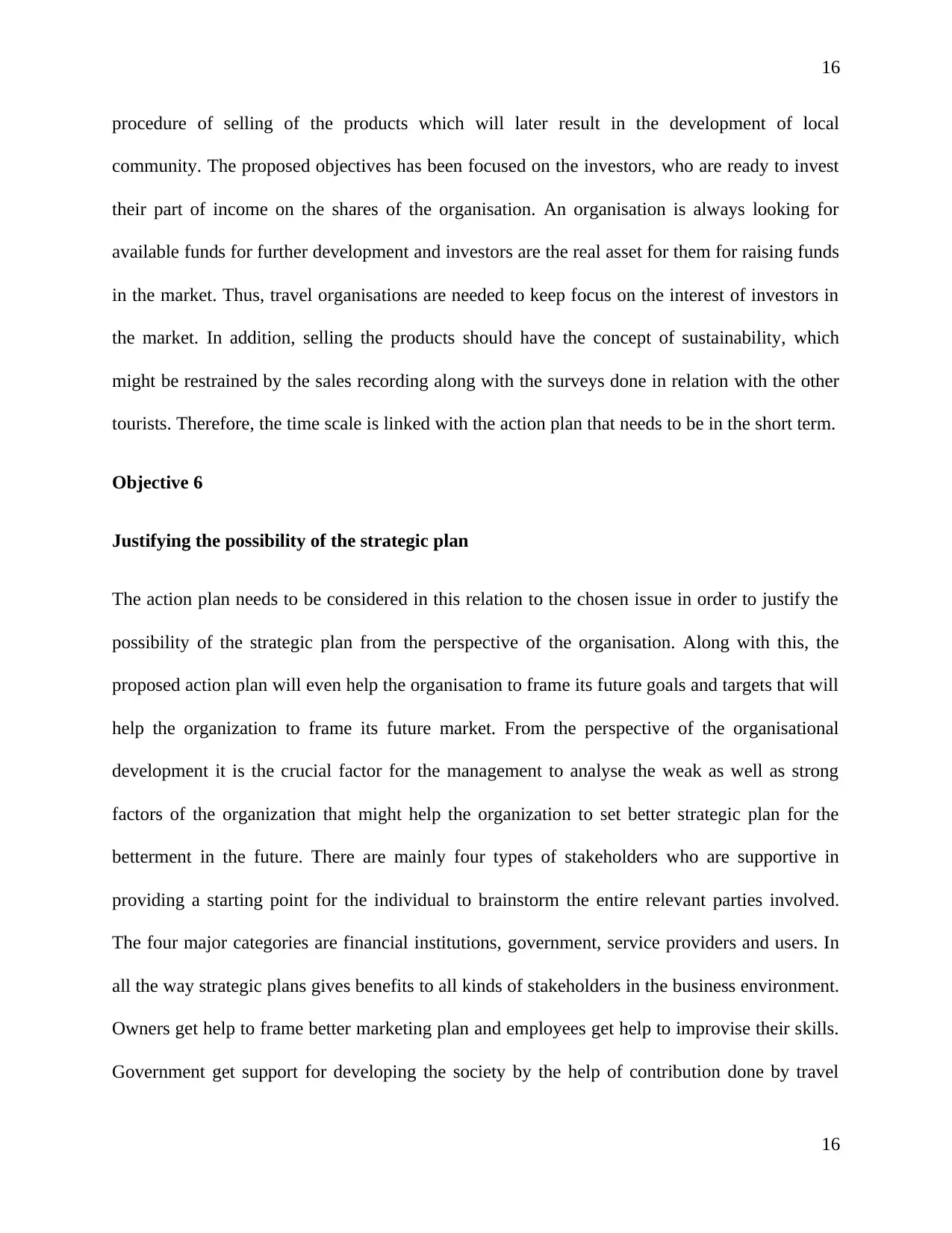
16
procedure of selling of the products which will later result in the development of local
community. The proposed objectives has been focused on the investors, who are ready to invest
their part of income on the shares of the organisation. An organisation is always looking for
available funds for further development and investors are the real asset for them for raising funds
in the market. Thus, travel organisations are needed to keep focus on the interest of investors in
the market. In addition, selling the products should have the concept of sustainability, which
might be restrained by the sales recording along with the surveys done in relation with the other
tourists. Therefore, the time scale is linked with the action plan that needs to be in the short term.
Objective 6
Justifying the possibility of the strategic plan
The action plan needs to be considered in this relation to the chosen issue in order to justify the
possibility of the strategic plan from the perspective of the organisation. Along with this, the
proposed action plan will even help the organisation to frame its future goals and targets that will
help the organization to frame its future market. From the perspective of the organisational
development it is the crucial factor for the management to analyse the weak as well as strong
factors of the organization that might help the organization to set better strategic plan for the
betterment in the future. There are mainly four types of stakeholders who are supportive in
providing a starting point for the individual to brainstorm the entire relevant parties involved.
The four major categories are financial institutions, government, service providers and users. In
all the way strategic plans gives benefits to all kinds of stakeholders in the business environment.
Owners get help to frame better marketing plan and employees get help to improvise their skills.
Government get support for developing the society by the help of contribution done by travel
16
procedure of selling of the products which will later result in the development of local
community. The proposed objectives has been focused on the investors, who are ready to invest
their part of income on the shares of the organisation. An organisation is always looking for
available funds for further development and investors are the real asset for them for raising funds
in the market. Thus, travel organisations are needed to keep focus on the interest of investors in
the market. In addition, selling the products should have the concept of sustainability, which
might be restrained by the sales recording along with the surveys done in relation with the other
tourists. Therefore, the time scale is linked with the action plan that needs to be in the short term.
Objective 6
Justifying the possibility of the strategic plan
The action plan needs to be considered in this relation to the chosen issue in order to justify the
possibility of the strategic plan from the perspective of the organisation. Along with this, the
proposed action plan will even help the organisation to frame its future goals and targets that will
help the organization to frame its future market. From the perspective of the organisational
development it is the crucial factor for the management to analyse the weak as well as strong
factors of the organization that might help the organization to set better strategic plan for the
betterment in the future. There are mainly four types of stakeholders who are supportive in
providing a starting point for the individual to brainstorm the entire relevant parties involved.
The four major categories are financial institutions, government, service providers and users. In
all the way strategic plans gives benefits to all kinds of stakeholders in the business environment.
Owners get help to frame better marketing plan and employees get help to improvise their skills.
Government get support for developing the society by the help of contribution done by travel
16
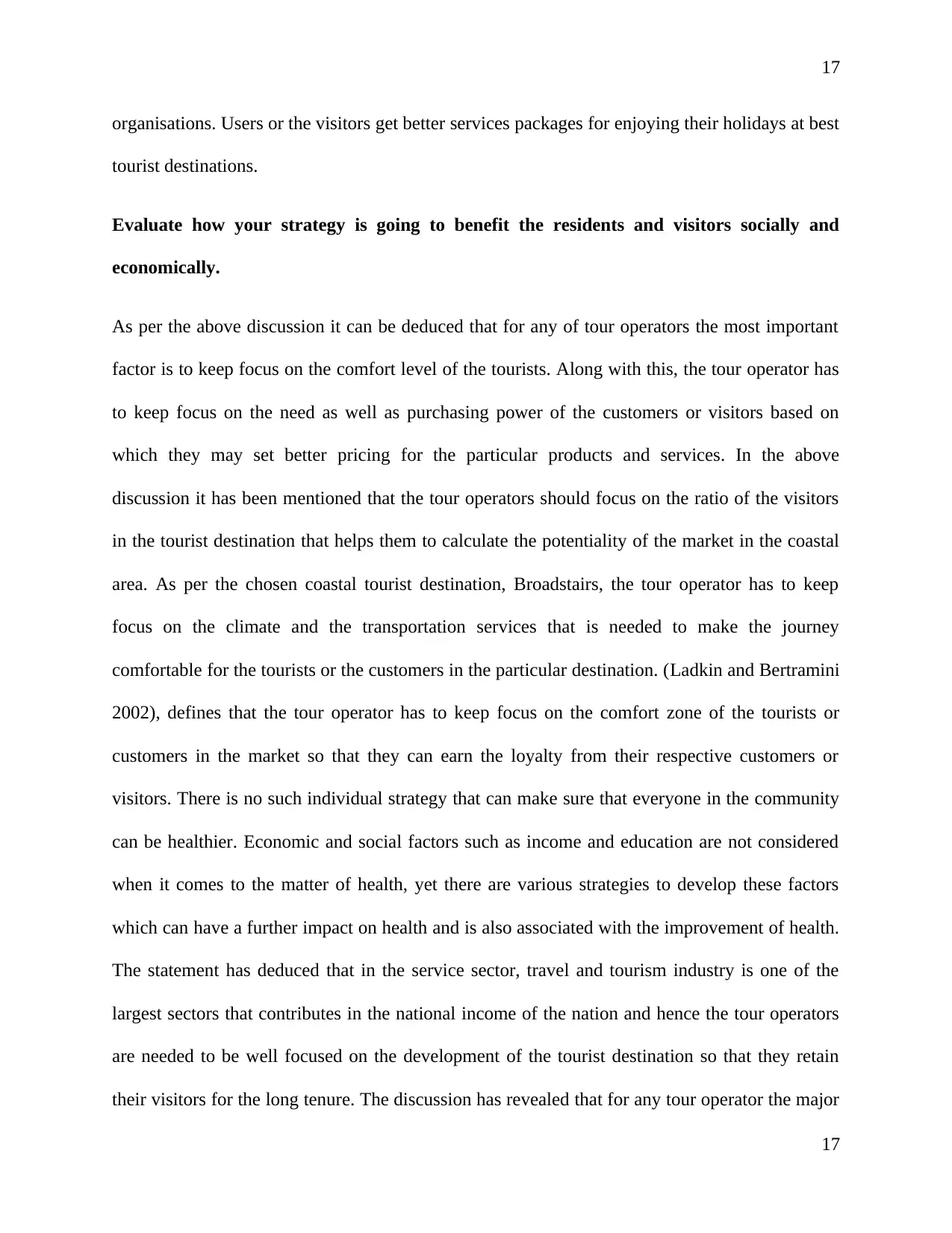
17
organisations. Users or the visitors get better services packages for enjoying their holidays at best
tourist destinations.
Evaluate how your strategy is going to benefit the residents and visitors socially and
economically.
As per the above discussion it can be deduced that for any of tour operators the most important
factor is to keep focus on the comfort level of the tourists. Along with this, the tour operator has
to keep focus on the need as well as purchasing power of the customers or visitors based on
which they may set better pricing for the particular products and services. In the above
discussion it has been mentioned that the tour operators should focus on the ratio of the visitors
in the tourist destination that helps them to calculate the potentiality of the market in the coastal
area. As per the chosen coastal tourist destination, Broadstairs, the tour operator has to keep
focus on the climate and the transportation services that is needed to make the journey
comfortable for the tourists or the customers in the particular destination. (Ladkin and Bertramini
2002), defines that the tour operator has to keep focus on the comfort zone of the tourists or
customers in the market so that they can earn the loyalty from their respective customers or
visitors. There is no such individual strategy that can make sure that everyone in the community
can be healthier. Economic and social factors such as income and education are not considered
when it comes to the matter of health, yet there are various strategies to develop these factors
which can have a further impact on health and is also associated with the improvement of health.
The statement has deduced that in the service sector, travel and tourism industry is one of the
largest sectors that contributes in the national income of the nation and hence the tour operators
are needed to be well focused on the development of the tourist destination so that they retain
their visitors for the long tenure. The discussion has revealed that for any tour operator the major
17
organisations. Users or the visitors get better services packages for enjoying their holidays at best
tourist destinations.
Evaluate how your strategy is going to benefit the residents and visitors socially and
economically.
As per the above discussion it can be deduced that for any of tour operators the most important
factor is to keep focus on the comfort level of the tourists. Along with this, the tour operator has
to keep focus on the need as well as purchasing power of the customers or visitors based on
which they may set better pricing for the particular products and services. In the above
discussion it has been mentioned that the tour operators should focus on the ratio of the visitors
in the tourist destination that helps them to calculate the potentiality of the market in the coastal
area. As per the chosen coastal tourist destination, Broadstairs, the tour operator has to keep
focus on the climate and the transportation services that is needed to make the journey
comfortable for the tourists or the customers in the particular destination. (Ladkin and Bertramini
2002), defines that the tour operator has to keep focus on the comfort zone of the tourists or
customers in the market so that they can earn the loyalty from their respective customers or
visitors. There is no such individual strategy that can make sure that everyone in the community
can be healthier. Economic and social factors such as income and education are not considered
when it comes to the matter of health, yet there are various strategies to develop these factors
which can have a further impact on health and is also associated with the improvement of health.
The statement has deduced that in the service sector, travel and tourism industry is one of the
largest sectors that contributes in the national income of the nation and hence the tour operators
are needed to be well focused on the development of the tourist destination so that they retain
their visitors for the long tenure. The discussion has revealed that for any tour operator the major
17
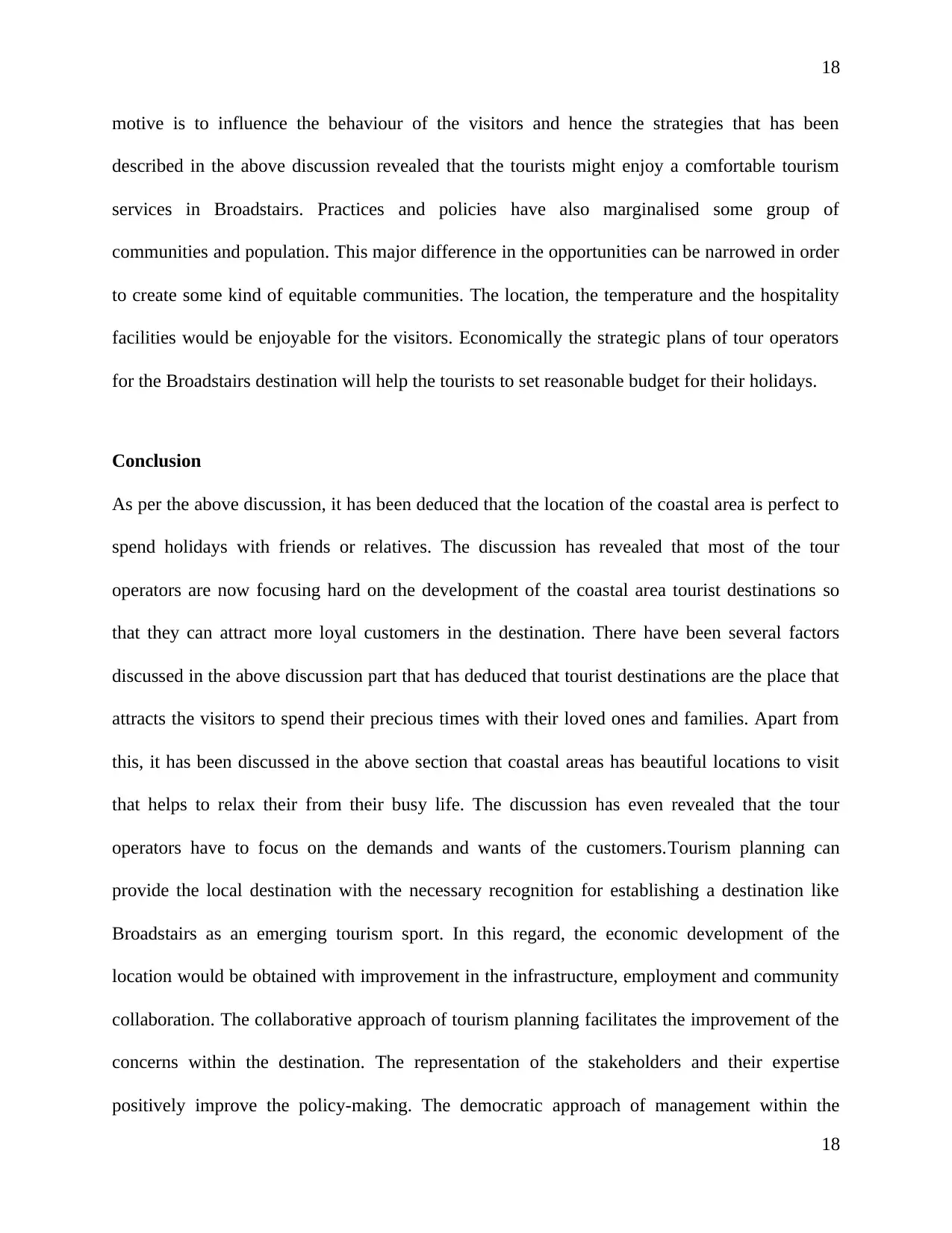
18
motive is to influence the behaviour of the visitors and hence the strategies that has been
described in the above discussion revealed that the tourists might enjoy a comfortable tourism
services in Broadstairs. Practices and policies have also marginalised some group of
communities and population. This major difference in the opportunities can be narrowed in order
to create some kind of equitable communities. The location, the temperature and the hospitality
facilities would be enjoyable for the visitors. Economically the strategic plans of tour operators
for the Broadstairs destination will help the tourists to set reasonable budget for their holidays.
Conclusion
As per the above discussion, it has been deduced that the location of the coastal area is perfect to
spend holidays with friends or relatives. The discussion has revealed that most of the tour
operators are now focusing hard on the development of the coastal area tourist destinations so
that they can attract more loyal customers in the destination. There have been several factors
discussed in the above discussion part that has deduced that tourist destinations are the place that
attracts the visitors to spend their precious times with their loved ones and families. Apart from
this, it has been discussed in the above section that coastal areas has beautiful locations to visit
that helps to relax their from their busy life. The discussion has even revealed that the tour
operators have to focus on the demands and wants of the customers.Tourism planning can
provide the local destination with the necessary recognition for establishing a destination like
Broadstairs as an emerging tourism sport. In this regard, the economic development of the
location would be obtained with improvement in the infrastructure, employment and community
collaboration. The collaborative approach of tourism planning facilitates the improvement of the
concerns within the destination. The representation of the stakeholders and their expertise
positively improve the policy-making. The democratic approach of management within the
18
motive is to influence the behaviour of the visitors and hence the strategies that has been
described in the above discussion revealed that the tourists might enjoy a comfortable tourism
services in Broadstairs. Practices and policies have also marginalised some group of
communities and population. This major difference in the opportunities can be narrowed in order
to create some kind of equitable communities. The location, the temperature and the hospitality
facilities would be enjoyable for the visitors. Economically the strategic plans of tour operators
for the Broadstairs destination will help the tourists to set reasonable budget for their holidays.
Conclusion
As per the above discussion, it has been deduced that the location of the coastal area is perfect to
spend holidays with friends or relatives. The discussion has revealed that most of the tour
operators are now focusing hard on the development of the coastal area tourist destinations so
that they can attract more loyal customers in the destination. There have been several factors
discussed in the above discussion part that has deduced that tourist destinations are the place that
attracts the visitors to spend their precious times with their loved ones and families. Apart from
this, it has been discussed in the above section that coastal areas has beautiful locations to visit
that helps to relax their from their busy life. The discussion has even revealed that the tour
operators have to focus on the demands and wants of the customers.Tourism planning can
provide the local destination with the necessary recognition for establishing a destination like
Broadstairs as an emerging tourism sport. In this regard, the economic development of the
location would be obtained with improvement in the infrastructure, employment and community
collaboration. The collaborative approach of tourism planning facilitates the improvement of the
concerns within the destination. The representation of the stakeholders and their expertise
positively improve the policy-making. The democratic approach of management within the
18
Paraphrase This Document
Need a fresh take? Get an instant paraphrase of this document with our AI Paraphraser
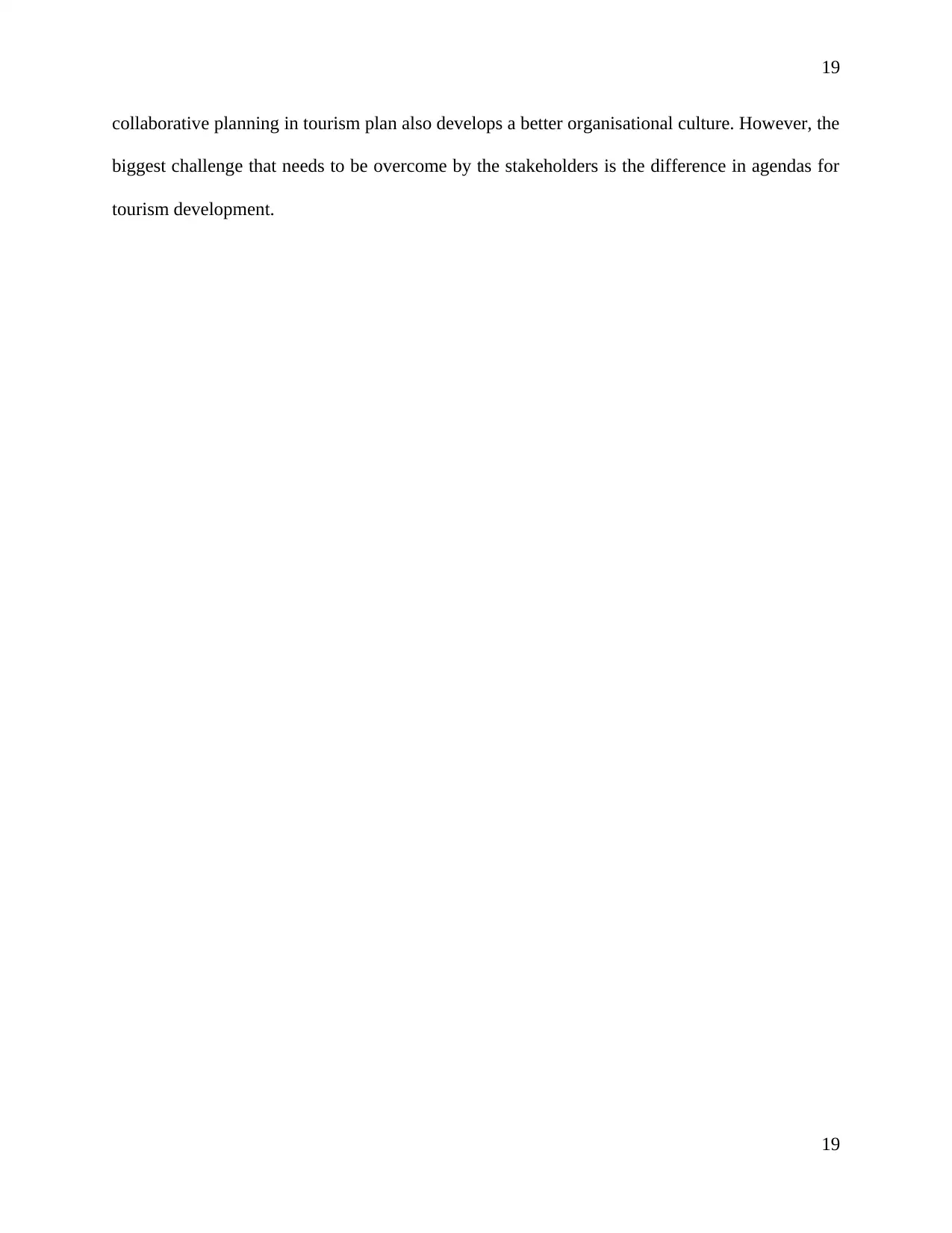
19
collaborative planning in tourism plan also develops a better organisational culture. However, the
biggest challenge that needs to be overcome by the stakeholders is the difference in agendas for
tourism development.
19
collaborative planning in tourism plan also develops a better organisational culture. However, the
biggest challenge that needs to be overcome by the stakeholders is the difference in agendas for
tourism development.
19
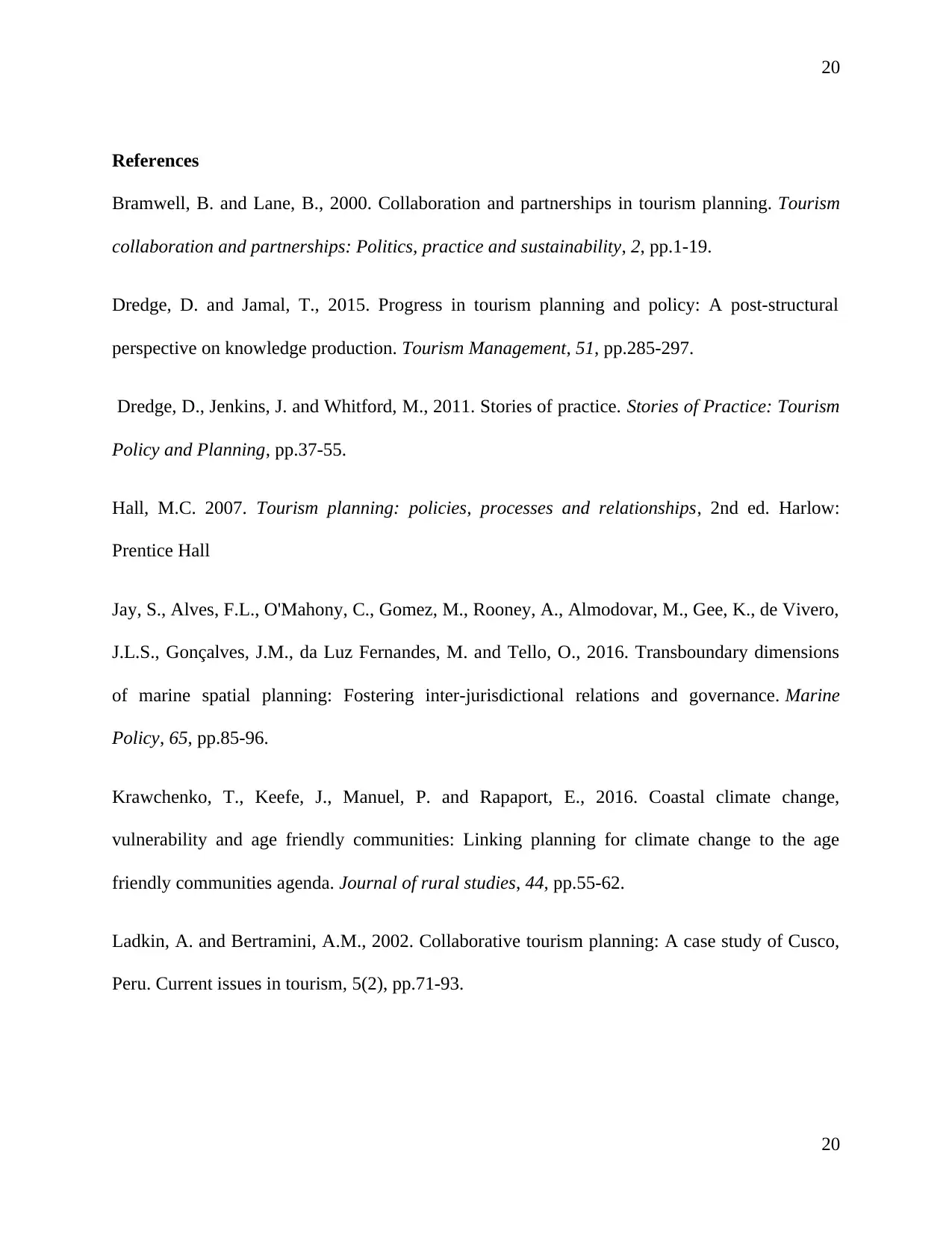
20
References
Bramwell, B. and Lane, B., 2000. Collaboration and partnerships in tourism planning. Tourism
collaboration and partnerships: Politics, practice and sustainability, 2, pp.1-19.
Dredge, D. and Jamal, T., 2015. Progress in tourism planning and policy: A post-structural
perspective on knowledge production. Tourism Management, 51, pp.285-297.
Dredge, D., Jenkins, J. and Whitford, M., 2011. Stories of practice. Stories of Practice: Tourism
Policy and Planning, pp.37-55.
Hall, M.C. 2007. Tourism planning: policies, processes and relationships, 2nd ed. Harlow:
Prentice Hall
Jay, S., Alves, F.L., O'Mahony, C., Gomez, M., Rooney, A., Almodovar, M., Gee, K., de Vivero,
J.L.S., Gonçalves, J.M., da Luz Fernandes, M. and Tello, O., 2016. Transboundary dimensions
of marine spatial planning: Fostering inter-jurisdictional relations and governance. Marine
Policy, 65, pp.85-96.
Krawchenko, T., Keefe, J., Manuel, P. and Rapaport, E., 2016. Coastal climate change,
vulnerability and age friendly communities: Linking planning for climate change to the age
friendly communities agenda. Journal of rural studies, 44, pp.55-62.
Ladkin, A. and Bertramini, A.M., 2002. Collaborative tourism planning: A case study of Cusco,
Peru. Current issues in tourism, 5(2), pp.71-93.
20
References
Bramwell, B. and Lane, B., 2000. Collaboration and partnerships in tourism planning. Tourism
collaboration and partnerships: Politics, practice and sustainability, 2, pp.1-19.
Dredge, D. and Jamal, T., 2015. Progress in tourism planning and policy: A post-structural
perspective on knowledge production. Tourism Management, 51, pp.285-297.
Dredge, D., Jenkins, J. and Whitford, M., 2011. Stories of practice. Stories of Practice: Tourism
Policy and Planning, pp.37-55.
Hall, M.C. 2007. Tourism planning: policies, processes and relationships, 2nd ed. Harlow:
Prentice Hall
Jay, S., Alves, F.L., O'Mahony, C., Gomez, M., Rooney, A., Almodovar, M., Gee, K., de Vivero,
J.L.S., Gonçalves, J.M., da Luz Fernandes, M. and Tello, O., 2016. Transboundary dimensions
of marine spatial planning: Fostering inter-jurisdictional relations and governance. Marine
Policy, 65, pp.85-96.
Krawchenko, T., Keefe, J., Manuel, P. and Rapaport, E., 2016. Coastal climate change,
vulnerability and age friendly communities: Linking planning for climate change to the age
friendly communities agenda. Journal of rural studies, 44, pp.55-62.
Ladkin, A. and Bertramini, A.M., 2002. Collaborative tourism planning: A case study of Cusco,
Peru. Current issues in tourism, 5(2), pp.71-93.
20
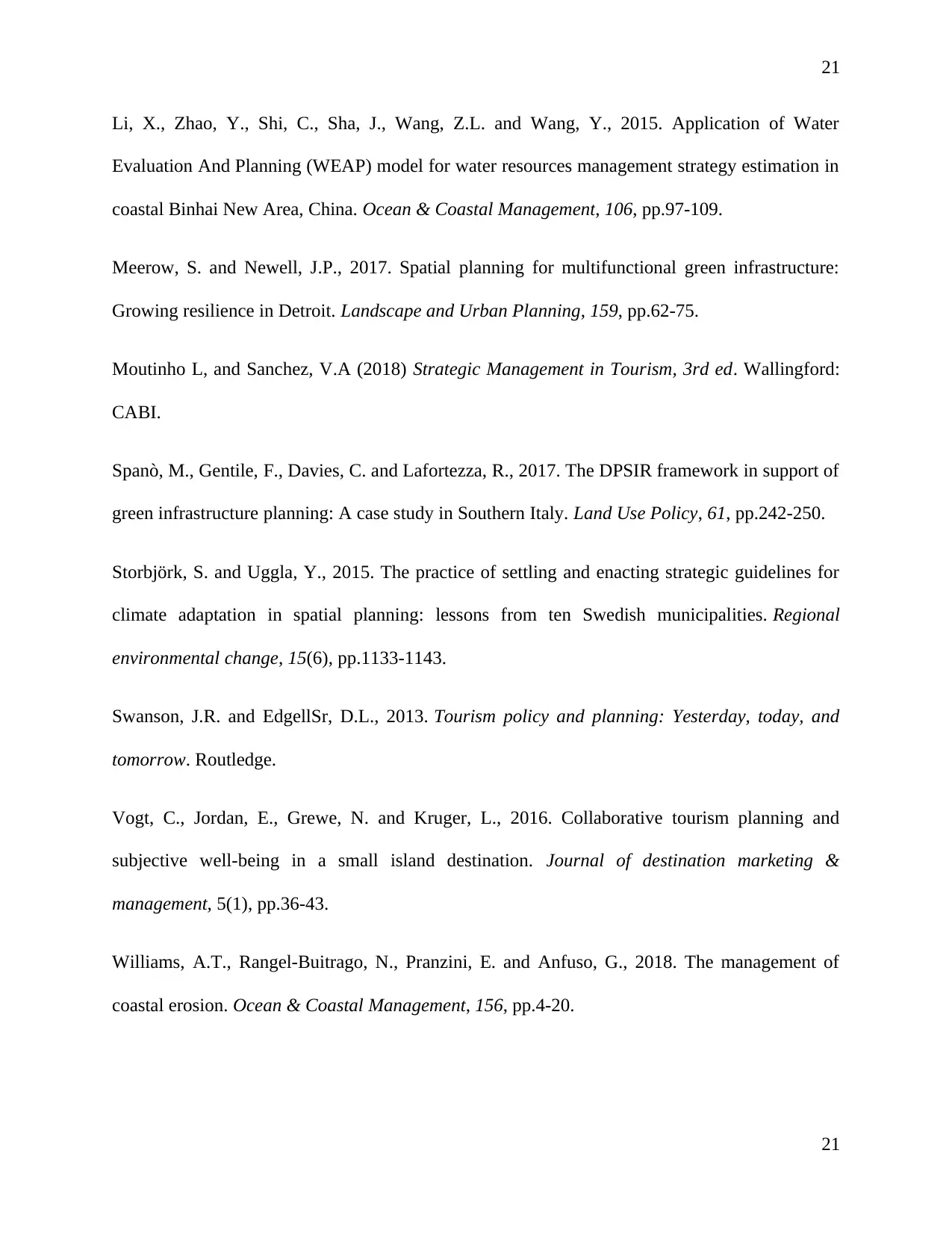
21
Li, X., Zhao, Y., Shi, C., Sha, J., Wang, Z.L. and Wang, Y., 2015. Application of Water
Evaluation And Planning (WEAP) model for water resources management strategy estimation in
coastal Binhai New Area, China. Ocean & Coastal Management, 106, pp.97-109.
Meerow, S. and Newell, J.P., 2017. Spatial planning for multifunctional green infrastructure:
Growing resilience in Detroit. Landscape and Urban Planning, 159, pp.62-75.
Moutinho L, and Sanchez, V.A (2018) Strategic Management in Tourism, 3rd ed. Wallingford:
CABI.
Spanò, M., Gentile, F., Davies, C. and Lafortezza, R., 2017. The DPSIR framework in support of
green infrastructure planning: A case study in Southern Italy. Land Use Policy, 61, pp.242-250.
Storbjörk, S. and Uggla, Y., 2015. The practice of settling and enacting strategic guidelines for
climate adaptation in spatial planning: lessons from ten Swedish municipalities. Regional
environmental change, 15(6), pp.1133-1143.
Swanson, J.R. and EdgellSr, D.L., 2013. Tourism policy and planning: Yesterday, today, and
tomorrow. Routledge.
Vogt, C., Jordan, E., Grewe, N. and Kruger, L., 2016. Collaborative tourism planning and
subjective well-being in a small island destination. Journal of destination marketing &
management, 5(1), pp.36-43.
Williams, A.T., Rangel-Buitrago, N., Pranzini, E. and Anfuso, G., 2018. The management of
coastal erosion. Ocean & Coastal Management, 156, pp.4-20.
21
Li, X., Zhao, Y., Shi, C., Sha, J., Wang, Z.L. and Wang, Y., 2015. Application of Water
Evaluation And Planning (WEAP) model for water resources management strategy estimation in
coastal Binhai New Area, China. Ocean & Coastal Management, 106, pp.97-109.
Meerow, S. and Newell, J.P., 2017. Spatial planning for multifunctional green infrastructure:
Growing resilience in Detroit. Landscape and Urban Planning, 159, pp.62-75.
Moutinho L, and Sanchez, V.A (2018) Strategic Management in Tourism, 3rd ed. Wallingford:
CABI.
Spanò, M., Gentile, F., Davies, C. and Lafortezza, R., 2017. The DPSIR framework in support of
green infrastructure planning: A case study in Southern Italy. Land Use Policy, 61, pp.242-250.
Storbjörk, S. and Uggla, Y., 2015. The practice of settling and enacting strategic guidelines for
climate adaptation in spatial planning: lessons from ten Swedish municipalities. Regional
environmental change, 15(6), pp.1133-1143.
Swanson, J.R. and EdgellSr, D.L., 2013. Tourism policy and planning: Yesterday, today, and
tomorrow. Routledge.
Vogt, C., Jordan, E., Grewe, N. and Kruger, L., 2016. Collaborative tourism planning and
subjective well-being in a small island destination. Journal of destination marketing &
management, 5(1), pp.36-43.
Williams, A.T., Rangel-Buitrago, N., Pranzini, E. and Anfuso, G., 2018. The management of
coastal erosion. Ocean & Coastal Management, 156, pp.4-20.
21
Secure Best Marks with AI Grader
Need help grading? Try our AI Grader for instant feedback on your assignments.

22
22
22
1 out of 23
Related Documents
Your All-in-One AI-Powered Toolkit for Academic Success.
+13062052269
info@desklib.com
Available 24*7 on WhatsApp / Email
![[object Object]](/_next/static/media/star-bottom.7253800d.svg)
Unlock your academic potential
© 2024 | Zucol Services PVT LTD | All rights reserved.





